#greg4cr
Text
4cr Plays - Piczle Cross Adventure (Switch)
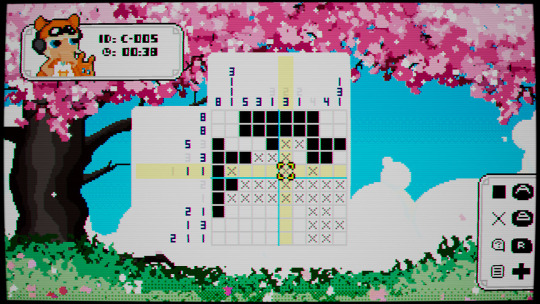
I am a nonogram fanatic. I don’t know what exactly it is about the things, but I just can’t get enough of the little draw-by-numbers puzzles. Few games suck me in as intensely as a good Picross (or the indie equivalent).
In the past, I thought I was more-or-less alone in this. Nonogram games were few and far between. I even found myself hunting down ROMs of Picross games released for the Satellaview broadcast service for the Super Famicom just go get my fix! Now, on the Switch, there are so many nonogram games coming out that I have actually found myself falling slightly behind!
The latest twist are games that wed nonograms with a broader gameplay structure torn from another genre. The ingenious Murder by Numbers combined nonograms with a visual novel revolving around solving crimes. The recent PictoQuest merged nonograms with RPG mechanics. Now, we have Piczle Cross Adventure, which places the puzzles within a story-driven 2D adventure.
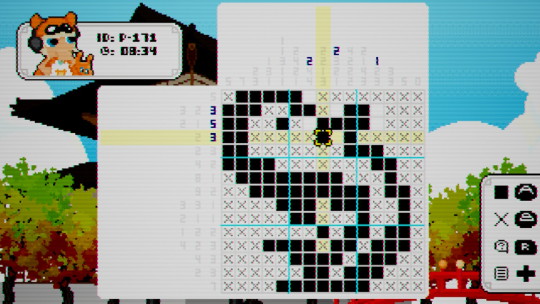
If you have never solved a nonogram puzzle before, let me explain the concept. You start with an empty grid. Each row and column of the grid has a series of numbers on it. Your goal is to fill the correct cells in the grid to create an image. You can think of it as a form of “paint-by-numbers”, where you need to identify the right spaces to mark for form a pixel-art painting.
The numbers on a row or a column tell you how many spots need to be filled in. If you see a “5″, you know that a five-block sequence will need to be filled, while blocks before and after those five will remain unfilled. To figure out which five need filled, you need to look at the corresponding columns (if you are working on a row) and see if you can match the conditions placed by the numbers on each of those. You will often see multiple numbers, like “2 3″, indicating that there are multiple sequences that will be filled in. In this case, the row would have a sequence of two filled-in blocks, then later, a second sequence of three filled-in blocks. At least one unfilled cell must exist between the two sequences. Again, you need to use the other clues to identify where the two sequences lie in the row.

That’s about all there is to it. Identify the spaces to fill, mark off those you know will not be filled, and try to complete the picture as fast as you can without making any mistakes. As pictures get larger, this becomes a tougher task. Even as a novice, you can probably complete 5x5 or 10x10 puzzles without breaking a sweat. As the puzzles grow, you may find it a little harder to keep track of everything. Still, try not to panic. A great thing about nonograms is that you should never have to make a blind guess. There is always enough information to unravel the next spot - it just may take some searching to identify it.
Piczle Cross Adventure presents its puzzles in a classic form, without additions like multiple colors or layers that have been used in other recent games. This is not a complaint, however, as the puzzles are well-designed. I’ve had a lot of fun chiseling my way through the game, and it has a lot of great little challenges in it. The primary enhancement on standard puzzles in Piczle Cross Adventure is that some larger pictures are broken up into a series of smaller puzzles. As you complete the individual small puzzles, you reveal that larger picture. In these cases, it may pay off to keep each surrounding piece in mind, as they will offer clues on where the borders of your current piece lie.

The most unique aspect of Piczle Cross Adventure is the inclusion of a massive overworld and story to guide your puzzle solving. The story revolves around the evil Mona Chromatic, who has unleashed the pixel-powered robot under_SCORE on the world in an attempt to rob it of its color. Score-chan, pet/companion(?) Gig, and Professor Matrix - the ostensible “protagonists” of the previous Piczle games - have set out to restore the zapped items and put the world together again.
This story is mainly a way to guide you from puzzle to puzzle. Each item is restored by completing a puzzle representing it. The overworld, presented in a 2D overhead Zelda-like manner, is broken up into a series of regions. Each region has a number of items to restore. Often, you will find that your progress is gated until you find a particular item from a different region. For instance, a fallen tree might block your progress in one direction until you restore a chainsaw in a different area and bring it back to clear the path.
Exploration of the overworld is not particularly deep. Other than unlocking items for simple puzzles, there isn’t a ton to do. You get XP for completing puzzles, but levelling up doesn’t really grant new abilities - beyond opening up more difficult puzzles. Still, it is a pretty compelling twist on the standard formula. Some puzzles are well-hidden, inside trash cans or behind trees. Hunting down every puzzle and filling in that section on your overworld map is an addictive process. The story and exploration give a nice feeling of progress as you work your way through.

As I mentioned, I played Piczle Cross Adventure on Switch. It is also available on Steam. I’d personally chose every time to play this kind of game on a portable system, so I’d recommend getting the Switch version. It looks nice on the tablet - though, I had to turn off the fake overscan. It also makes nice use of the HD rumble on the Switch. This is the kind of game that benefits from portability and being able to play a few puzzles in bed before you sleep.
Overall, I really enjoyed Piczle Cross Adventure. If you like nonogram puzzles, the ones in this game are really well designed. I also enjoyed exploring the overworld, trying to hunt down those last few obscure puzzles. If you’re looking for that next puzzle fix, this is definitely a game to look into.
A copy of Piczle Cross Adventure was provided for this review.
Nintendo eShop
Steam
1 note
·
View note
Text
4cr Plays - HyperParasite (PS4)
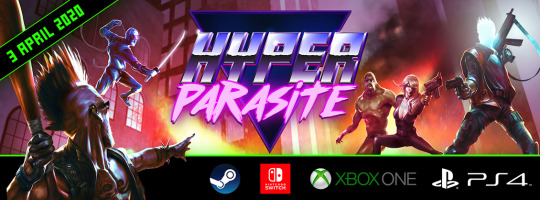
It is the grimdark 80′s. World War III has neared its conclusion, but humanity can’t stop to catch its collective breath just yet - a new threat has reared its ugly head. A parasite is moving across the planet, able to take control of helpless humans and wield their bodies like puppets in pursuit of doing incalculable damage. The President of the United States has offered a great reward to the one who brings this parasite down. Will humanity succeed?
Well, you better hope they don’t. In HyperParasite, you are the threat. Wave upon wave of human has lined up to take you down. Will you be able to survive?
I saw down this week with the PS4 version of HyperParasite. Read on for my impressions.
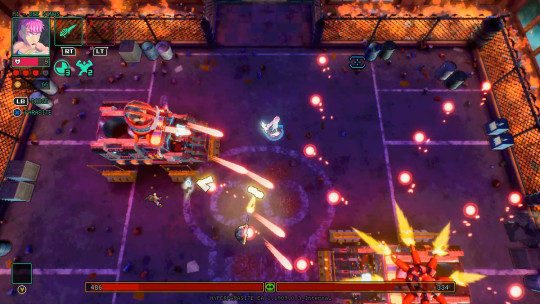
HyperParasite is a twin-stick shooter with rogue-like elements. That’s a whole mess of word salad, so what does that mean? If you aren’t familiar with the basic style, you progress through a series of randomly-generated levels presented with a top-down camera. You move your character with the left stick and aim attacks with the right. A tap of the right trigger unleashes your standard attack, while hitting the left trigger unleashes a powerful special attack (which requires a cool-down period before being used again). You can also dodge - allowing you to press a button to roll in the direction you are aiming. This is essential if you want to survive.
Each level is randomly generated from a set of themed tiles. Each time you die, a new version of the level is generated. A level is made up of a series of rooms. Defeating the enemies in a room allows you to move on in any of the open directions. At the end of a level lies a boss. If you are able to make it past that boss, you get to move forward.

The key twist in HyperParasite is your ability to take over different enemies. On your own, you are extremely weak. At the beginning, a single hit is enough to take you out. However, you can take control of the bodies of enemies, wielding them like fleshy little puppets. When you take over a body, you can use both the normal and special attack of that person. You also use their body as a suit of armor, allowing you to take a few hits without dying. You can discard the current host body at any time - and if they die, you are forcibly evicted - leaving you free to find a new host.
There are a number of different types of people you can possess. For instance, a homeless guy attacks by thrusting his shopping cart. As the cop, you can fire your service pistol, while the boxer can unleash deadly close-range attacks. Each type of person has their own attacks and play styles, leading to strategic decisions about who to take over and when to switch bodies to avoid leaving yourself vulnerable.
However, you cannot just reach out and take over anyone you like. You first have to unlock the ability to possess that character type. The first time you defeat a character of a particular type, you can collect their brain. If you can make it to a shop - there is one in each level - with the brain, you can start to work on unlocking them. Unlocking a character type requires a certain quantity of coins - gained from killing enemies. Basic characters come cheap, but stronger characters will require quite a lot of cash.

You can also use money to purchase upgrades or to store bodies for use later. In addition, you will find upgrades scattered around each level. These upgrades can either give you more health in your parasite form, give you greater attack power, or improve your defense. I recommend going straight for health before even considering anything else. At the start, one hit is enough to kill you. Additional health gives you a bit more protection when you are forced to switch bodies.
When you die, you lose all upgrades and start the level over. However, the bodies that you’ve unlocked or put coins into remain as they were. This means that you carry over the ability to take over certain character types after death, granting some sense of progress.
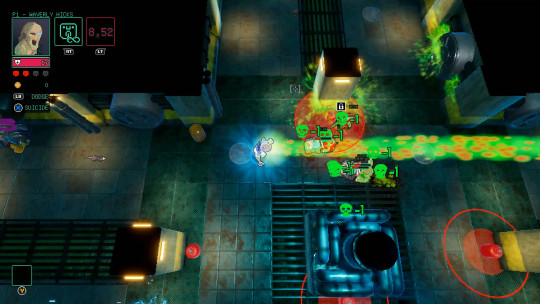
To be honest, when I was offered a chance to try HyperParasite, I was skeptical. I’ve put quite a few hours into the Geometry Wars games over the years, but have never really sought out these kind of shooters. I also normally avoid rogue-likes entirely. I hate losing a lot of progress when I die, I get frustrated by cheap, artificially-induced difficulty in games, and I generally find procedurally-generated levels to be uncreative.
However, I ended up really enjoying HyperParasite. I was impressed by how responsive the controls feel. Movement is smooth and snappy, and when I died, I felt like I could generally pinpoint the actual mistake I made. The game is tough, but fair. It doesn’t feel hard for the sake of being hard. Rather, it just feels like a modern take on an arcade game. I also really like the core possession mechanic. There are fun differences between characters, and I enjoy how often you switch between them. It feels fresh. Getting back in after death is also snappy, so dying isn’t a major annoyance.
I played HyperParasite on PS4. It isn’t exactly a technically demanding game, so I encountered no real issues. It is launching this week on PC and all three consoles, so you can check it out on any platform you happen to own. I would actually recommend the Switch version. This is a great game for quick sessions, and isn’t something so nice looking that you have to put it on a big screen.
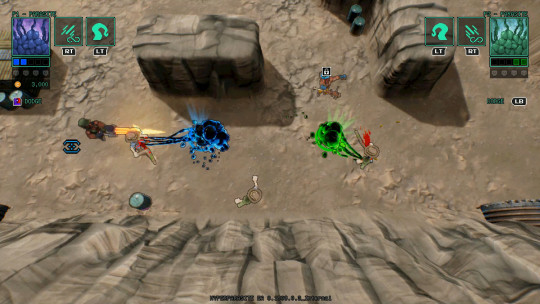
Overall, I was pleasantly surprised by HyperParasite. The core idea - taking over different types of enemies and using their attacks - is really clever and well implemented. The game feels good to play, and manages to be tough while retaining some fairness. If you’re interested, I recommend giving it a try.
A copy of HyperParasite was provided for this review.
Official Website
1 note
·
View note
Text
4cr Plays - Shovel Knight: King of Cards (Switch)
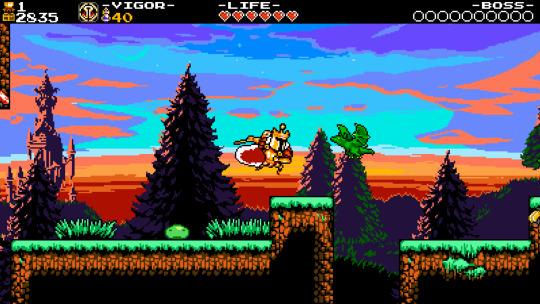
Shovel Knight was one of the greatest successes of the Kickstarter boom of the early 2010s. The original campaign, promising a Mega Man-inspired side-scroller with a few clever twists and an inspired visual style, found an audience hungry for that style of game. It would be next to impossible to argue that the developer, Yacht Club Game, failed to deliver on their promises. Shovel Knight was a breath of fresh air - a game that was inspired by what had come before, but was unafraid to carve out its own niche and push the genre forward.
Since the initial release in 2014, the developers have developed add-on campaigns, including Plague of Shadows, and Specter of Torment. Finally, over five years later, the final expansion - King of Cards - has been released. It’s been a heck of a ride. Does the final piece stick the landing?

For those who have yet to play any of the campaigns, the basic idea is that Shovel Knight is a two-dimensional side-scroller. You move from left to right, collecting treasure, jumping over obstacles, and bashing enemies. Specifically, Shovel Knight takes after the Mega Man series. This means that each level is fairly substantial in length, and ends in a boss battle. The game is also quite action focused, requiring both careful navigation of environmental hazards while simultaneously fighting enemies.
Each level has multiple checkpoints. These are optional - you can choose to break a checkpoint, disabling it. If you break a checkpoint, you will earn a bonus at the end, but lose its use on death. This introduces an interesting risk versus reward scenario, where you can accept greater potential reward at the risk of greater frustration when you die.
As you progress, you collect treasures scattered throughout the level. Treasure also can be obtained from chests and defeating enemies. This treasure can be spent on health and damage upgrades. Players have infinite lives, but each death costs some of your money. You can recover that money by collecting sacks that appear around your body, but this - too - is risky.

King of Cards, the newest and last campaign, is a prequel. A card game called “Joustus” has spread across the kingdom and a tournament has been called to determine the “King” - the one who is the best in all the land at Joustus. In King of Cards, you fill the shoes of King Knight, who hopes to become the Joustus king by defeating the three judges - King Pridemoor, the Troupple King, and King Birder.
Each campaign puts you in control of a new character, each with a different movement style and weapon. The means that each campaign feels quite a bit different from the previous campaigns. The same is true this time. King Knight has a flashy fighting style built on leaping bashes. If you’ve played the Wario Land series, you know what to expect here. King Knight throws his hefty body through the air, bouncing into enemies, digging into treasure, and breaking through barriers.
Like in the previous campaigns, the levels in King of Cards are built around the particular fighting style of King Knight - focused on careful twirling through the air. The levels tend to be a bit shorter, but there are more of them, leading to a playtime around eight hours - similar to the original game and Plague of Shadows, and a little longer than Specter of Torment.
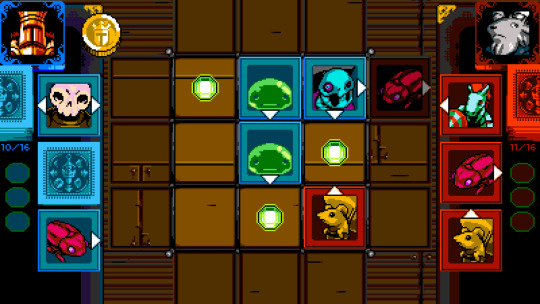
Given the story description above, you won’t be surprised to read that the other major gameplay enhancement this time around is the addition of the card game Joustus. In the game, each player has a deck of 16 cards. There are 120 different cards that you can collect and use to form your deck. Each card represents an enemy or character from the series. The main goal is to collect more gems than your opponent. This is done by pushing cards towards gems on a grid. Each card you put into play has arrows indicating directions they can be pushed or can push themselves. There are also moves that blow up cards or double their movement and abilities that push multiple arrows or change direction. You want to avoid having your cards pushed into the graveyard, and you do want to push your cards onto the gems. You can see both your hand, and the hand of your enemy, so success at Joustus largely revolves around planning a few moves ahead and playing cards accordingly.
In practice, Joustus is a little complicated, but you can figure it out with a little bit of experimentation. Unfortunately, experimentation is also a little hard since opponents can steal your cards after each loss. You can buy cards back, but this - too - will suck away your gold. Unfortunately, there is not a good tutorial in the game for Joustus. The plus side - if you end up hating it - is that Joustus is optional. You can beat the game without ever winning at it.
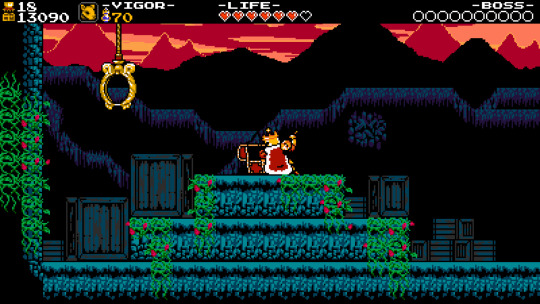
One area where Yacht Club Games continues to excel is in the art direction. I’ll be the first on-the-record to state that I’m a little tired of pixel art. Too many games rely on retro-throwbacks, and it gets stale. Shovel Knight is an exception. The colors really pop, the art is detailed, and the character designs are excellent. King of Cards is a fantastic looking game, like all of the other Shovel Knight campaigns have been before it.
Overall, King of Cards is a good conclusion to the Shovel Knight saga. I didn’t have quite as much fun with it as with some of the previous campaigns, and the Joustus card game is nothing special. However, the core side-scrolling is very fun, and I enjoyed the gameplay twists added by the new character. If you’re curious about the full experience, grab the Treasure Trove collection and start with the original campaign. If you’ve been along for the ride the whole time and craving more Shovel Knight, King of Cards won’t disappoint.
A copy of the Treasure Trove collection was provided for this review.
Official Website
Nintendo eShop
0 notes
Text
4cr Plays - SteamWorld Quest: Hand of Gilgamech

Swedish developers Image & Form have taken on a variety of genres with the versatile SteamWorld setting. SteamWorld Dig and Dig 2 were gorgeous, polished takes on the sidescrolling action-adventure. SteamWorld Heist presented an addictive take on the turn-based strategy game. SteamWorld Tower Defense was, well, a creative take on its namesake.
Now, Image & Form are back with their most ambitious release yet. SteamWorld Quest: Hand of Gilgamech is the studio’s riff on the RPG genre, with an addictive card-based battle system.
Read on for my impressions.

SteamWorld Quest places you in the armor-plated shoes of Armilly - the grocer’s daughter, who dreams of living up to the legend of her hero, Gilgamech - Copernica - a college dropout who wants to bring alchemy to the people - and Galleo - a craftsman looking for a way out of his mother’s basement. Their little village is attacked by an army of mechanical monsters, and the professional adventurers prove to be completely useless. Suddenly, Armilly, Copernica, and Galleo find themselves in the spotlight, as the only ones who can repel the invaders and save the world.
The plot of SteamWorld Quest is essentially the hero’s journey at the heart of many fantasy novels. It’s a fun ride, and the charming dialogue really carries the experience. I fell in love with the characters from almost the start - you can’t help but love Copernica’s sarcasm and Armilly’s sheer, puppy-like earnestness. The general tone of the game is perfect. It’s a little tongue-in-cheek, and throws a few fun winks at the player without getting obnoxious. I expected finely-tuned gameplay from Image & Form, but was genuinely surprised how much I enjoyed the writing too.

SteamWorld Quest is presented as a series of chapters, each essentially a sidescrolling “level” to explore. Whether forest paths, a dungeon, or a damp cave, you move between a series of rooms full of enemies, characters to talk to, merchants, and obstacles. You can destroy items to collect gold, and search for chests full of items. Your map shows the rooms that you’ve explored, and indicates missed paths. Of course, there are also hidden rooms not indicated on the map, so there is incentive to explore each area as much as you can.
If you get close to an enemy, combat begins. Battles are turn-based, alternating between groups - that is, your party takes a turn, then the enemy party takes a turn (rather than alternating between individual characters). Combat is card-based. Each of your three party members has a deck of eight cards, which are shuffled together to form your deck. You draw a hand of six cards at the start of the battle, and draw back up to six each turn. On a turn, you may perform up to three actions. You could play three cards, or use up to three items - like health-restoring potions - instead.
The actions you can choose are determined by your SP - “steam points”. Each character has cards that represent basic actions, either simple attacks, stat modifiers, and such. Basic actions are weak, but they cost nothing to use and grant you one SP. More powerful cards - attacks, healing, powerful spells - cost one or more SP to play. SP is held in a shared pool for the party. When choosing skills, you need to decide whether to focus on one character’s cards, or whether to spread actions between party members. If all three cards belong to the same character, you get to execute a special fourth action for that character. However, some skills are more powerful if paired with another character’s abilities. Other times, it might make sense to pair one character’s mighty attack with another’s healing touch.

Using a card takes it from your hand to the discard pile, putting it out of play until the existing deck is used up. Fortunately, with a combined deck size of 24, it is never long until discarded cards come back into play. You can also freely discard two cards each turn and draw replacements immediately. This is a great touch, helping you get out of situations where you feel “stuck” and allowing you to gamble on a definite - but weak - turn versus a potentially great turn. Since you get cards back eventually, you have a lot of freedom to try to manipulate your hand.
Each character has their own specializations, strengths, and weaknesses. Armilly is your standard “knight”, excelling at physical attacks and defense. Copernica is the “wizard”, with elemental magic attacks. Galleo is your support character - your “priest” - with healing skills, the ability to inflict status ailments like poison on enemies, and stat manipulation abilities. This impacts the kind of skills they each bring to the table, and what you can expect out of them in combat.
Each character has stats (the typical RPG ones, like strength, magic, constitution, etc.). Armilly is good at physical strikes, Copernica is not. However, Copernica makes up for a lack of strength with powerful element-based magic attacks. You also equip weapons and accessories to improve your stats, and attacks do damage based on these stats. For example, an ice attack that does 120% magic damage does 12 damage if your magic stat is 10.

You can have three party members at one time, and eventually do meet more characters that join the adventure. Like Armilly, Copernica, and Galleo, each additional character brings their own unique twists to the combat formula, and it is worth experimenting with part composition to find the one that works for how you play the game. Unfortunately, only the active party members gain experience, so unused characters quickly fall behind.
Each character has their own deck of cards. You find new cards throughout the world, and defeated monsters yield materials that can be used to craft new cards at the merchant. Very quickly, you end up with many more cards than can be used in your eight card deck, and choosing the right cards becomes an interesting optimization problem. You have to consider not just that character in isolation, but also the decks of the rest of the party. Galleo might not be the strongest attacker, but you still might want to include some of their attack cards to not end up in a situation where you only have healing cards. However, reasonably frequent save points and the ability to resurrect enemies give you a lot of freedom to explore different deck configurations.
The battle system is incredible. I have had a blast experimenting with different party and deck configurations, and the element of random draws adds a lot of interesting little surprises and chances to plan out a series of actions. There is a huge amount of depth to each aspect of combat. Yet, at the same time, the system is easy to immediately understand. You never feel lost in a series of dense mechanics. It’s a wonderful case of “easy to understand, hard to master”.

SteamWorld Quest is also a gorgeous game, especially on the Switch’s tablet screen. The art has a hand-drawn, painted quality to it. The blend of steampunk and fantasy is really appealing - mixing traditional concepts like wizards and knights with gears and bolts - and I love the interesting little details in all of the character designs, like how the cards look like old-school punchcards. There is a nice variety of environments to explore, and the developers have made great use of color to present a richly detailed world. I have played almost entirely in portable mode, but the game looks wonderful both on the TV and on the go.
SteamWorld Quest is one of the most enjoyable RPGs I’ve played recently, and it’s easy to get sucked into. Once again, Image & Form have put out a wonderfully polished, creative take on a well-known game genre, and I think they’ve outdone all of their past efforts. If you like card games or RPGs, you should definitely give this a go.
This review is based on a copy of the game provided by the developers.
Official Website
Nintendo eShop
9 notes
·
View notes
Text
4cr Plays - Dragon Marked for Death

Through games like Azure Striker Gunvolt, indie developer Into Creates has made their name by dragging Mega Man-style sidescrollers into the modern era. Dragon Marked for Death is their latest update of a classic style - a class-based action sidescroller designed for four-player co-op.
I sat down with the game over the past few days and put it through the paces. Read on for my impressions.
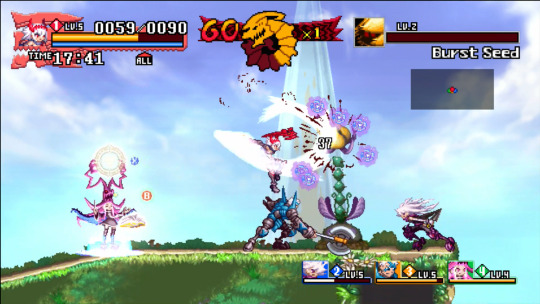
Dragon Marked for Death is described by its creators as a 2D “Action RPG”. This is technically accurate, but I don’t think it quite describes the full picture. The best starting place is to consider a sidescrolling action game like Mega Man. You have a series of stages, filled with traps and deadly enemies. You move left and right through that stage, defeating enemies with a variety of attacks - you get the idea.
Each stage has a time limit, and your goal is to defeat the boss within that limit. Complicating this is, of course, a small army of monsters. Also complicating matters is that stages are huge, and full of secrets to find, including items and treasure. Now, your first inclination might be to rush to the boss - and you certainly can play that way - however, this is where the RPG portion comes in. The game has an XP system, and defeating enough monsters to advance is absolutely essential to progressing. In addition, healing items are scarce, so you’ll need to collect money to remain stocked. Both of these factors create an incentive to explore as much as possible. In a way, Dragon Marked for Death presents an interesting optimization problem - how do you make the most of the time limit?
For me, this problem was more frustrating that exciting. My inclination is to explore as much as possible. I really want to dive into every nook and cranny in a level, and the time limits absolutely prevent this - especially as a solo player. This drove me a little crazy. How I wanted to play the game is not compatible with how it is designed. This is a normal part of gaming, of course, but it is one reason the game hasn’t quite clicked with me yet. Others, however, may find the idea of optimizing a playthrough to be absolutely thrilling.
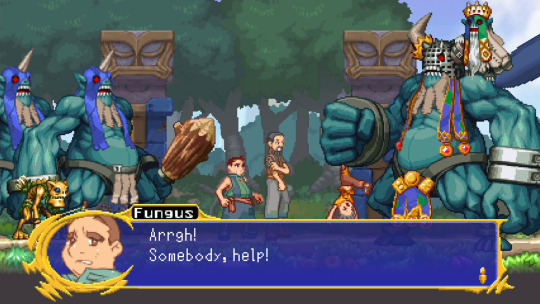
Experience points are not the only trapping of the RPG genre that carry over. More important is the concept of the character class. In fact, the classes are the reason that Dragon Marked for Death has a confusing purchasing model. Here is the deal - there are four total character classes. When you purchase the game, you get two. The remaining two can then be added as DLC. This is why the game is split into two different listings on the eShop. $15 gets you either the “Frontline Fighters” pack - featuring the Empress and Warrior - or the “Advanced Attackers” - featuring the Shinobi and Witch. A physical release, coming later this year, comes with all four classes (and costs the price of both packs). Although this model is a little confusing, I also think it’s a cool way to reduce the overall cost. You can start with two classes and add the others in if you fall in love with the game.
The Frontline Fighters classes, the Empress and Warrior, are the best starting point for learning how to play the game. They are also the ones I have tried so far. The Empress fights at close range with a sword, but can also unleash magical attacks through her “Dragon Arm” - either a projectile or a giant sword. She balances ranged and melee attack. The Warrior is more of your traditional “tank”. He is a close-range fighter that can take a beating, and he can create shields that protect himself and allies.
The Advanced Attackers, then, are slightly more complex classes for experienced players. The Shinobi is built around speed and dodging. He can glide through the air, and can unleash powerful kick attacks. Finally, the Witch can cast magical attacks, heal allies, and create platforms. She is intended to fill a support role. Her magic is powerful, but she is defenseless while casting it.

This brings me to a detail I had not discussed yet. Dragon Marked for Death can be played as a single player game, but it is absolutely designed as a co-op multiplayer experience. You can join with up to three friends to complete missions and build your characters. I have played both single and multiplayer, and you can tell that the game is built around a multiplayer experience. Many levels are prohibitively difficult for a solo player, and I got a bit frustrated with the game before I tried it with friends. Keep that in mind - you can give it a go alone, but be prepared to treat it as more of a “Souls” experience. You will die more often, and you will repeat more levels. Some of the character classes, like the Witch or Warrior, also do not show their full potential until you join with others.
If you are a fan of pixel art, Dragon Marked for Death is a treat for the eyes. The sprite work is fantastic - with huge, detailed character models and richly decorated stages. It looks fantastic on the Switch screen in portable mode. The colors and details really pop off the screen. It’s a great looking game.
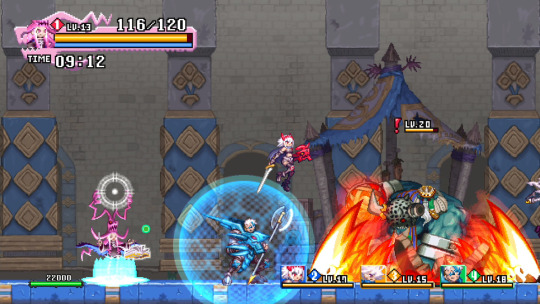
Dragon Marked for Death has left mixed impressions with me. There are some major positives - the game looks wonderful, the character classes add variety, and the combat is fairly deep. However, other aspects have kept it from really sucking me in. I still don’t love the strict time limits, and I’d rather have difficulty that adjusts based on the player count - I don’t tend to play many multiplayer games, and this could have been a great single-player distraction if not for the frustrating balance. The great thing is that the price of entry is fairly low. If you are intrigued - and if you have any friends also interested - it may be worth picking up one of the two character packs and giving it a try.
Official Website
Nintendo eShop (Frontline Fighters)
Nintendo eShop (Advanced Attackers)
3 notes
·
View notes
Text
4cr Plays - Baba is You

Every now and then, a game comes along that surprises you. One of those games that was not at all on your radar, comes along, and just ends up getting stuck in your brain for weeks and months after you give it a go.
Baba is You, a puzzle game from Arvi Teikari - also known by the username Hempuli - is the latest game to surprise me in that way. I vaguely remember seeing Baba is You in a recent Nintendo Direct, but it just didn’t catch my eye. Last week, I got the chance to give the game an early look. It left me stunned.
Baba is You is built around a simple - yet radical - concept. Let the player directly manipulate the rules that govern gameplay. A blend of perfect execution, polish, and charm result in the most memorable game of the year so far.
Read on for my impressions.
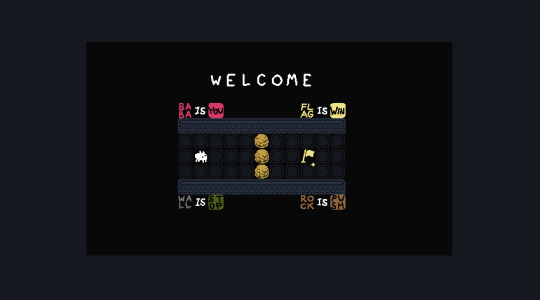
Baba is You is one of those games where the core mechanic is intuitively simple, but actually a little hard to explain. Let’s see... You are Baba, a delightfully cute little bunny thing. You wander through levels, presented from an overhead view, with the goal of finding the flag. Touch the flag, and you win. Except... Well... It’s not actually that simple. Sometimes you are not Baba. Sometimes touching the flag is death. Heck, sometimes you are the flag and want to touch Baba to win. Yeah, OK.. Not that simple.
Let’s try this with a visual aid. As they say, a picture is worth a thousand words.
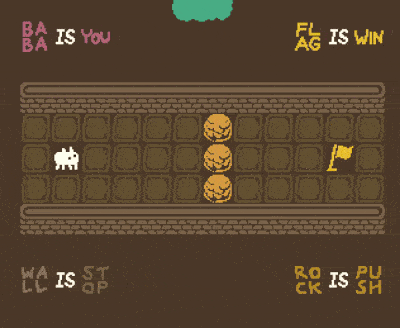
Alright. See those words? Those are the rules of the world. You are Baba, the cute little bunny thing. Great. You can push rocks. You cannot walk through walls. Touching the flag results in you moving on to the next level. That’s pretty straightforward. All games operate under some set of rules - Baba is You just happens to place those rules on the screen.
Except that those rules are not just on the screen for purposes of a tutorial. Those words are part of the world, and can be directly manipulated by the player. Remove a word from a rule, and suddenly the rule is void. Don’t like the walls preventing progress? Just push a word out of that rule and, suddenly, walls have no meaning and no effect.
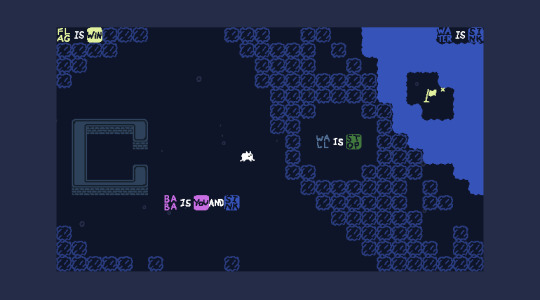
That said, this is not just a way to let you break rules. Because those words can be moved around, that means that you can combine words to form new rules. Replace Baba with “wall”, and now you are the walls. Pressing a direction on the d-pad will now cause the walls to shift and Baba to remain where you last left them. Think that touching a rock should allow you to win? Well, just replace the “flag” with the word “rock”, and you can do just that - as long as there is a way to get the word where you need it under the current set of rules.
Does that make more sense? Baba is You is a game that takes the explicit rules that define gameplay, and places them - to some extent - in the hands of the player to change. Baba is You is a puzzle game about pushing, breaking, reshaping, and working within and around the rules of the game world in order to complete the objective of a level.
This core twist is brilliantly clever, and can be devilishly insidious. This quick description might make it sound like the ability to reshape the rules would make it incredibly easy to complete a level, but the opposite is generally the case. You do not have free rein over all rules of the world - you have to be able to access them and the parts you want to use to manipulate them. In practice, it’s far easier to irrevocably break the rules, leaving the level in a state where it is impossible to finish.
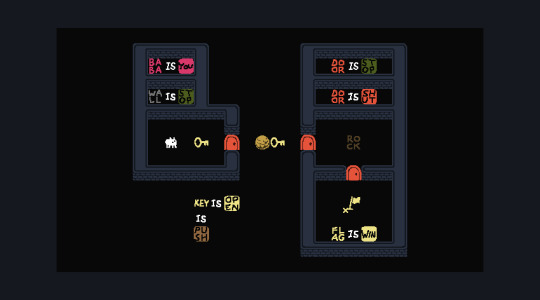
As a result, this game was an incredible surprise to me. The core mechanic is something that makes immediate intuitive sense, but still results in ridiculously deep gameplay. You will spend an hour staring at a puzzle, only to find that the answer was actually the simplest possible one. This is not a game that you marathon, but one that you savor - playing for a puzzle or two at a time. It is a game where you will stop playing, but wake up in the middle of the night after suddenly realizing how you needed to approach the latest roadblock. Even the smallest, simplest puzzles are clever, and the big, meaty puzzles will leave you sweating for awhile.
Yet, the game never gets frustrating. Because of the nature of the core mechanic, trial-and-error is built into the game in a tactile manner. Each trial you take feels like an experiment, and the variables are just sitting there to control. You can restart a level with a single button press when you mess up, and you can use another button to undo your last move - with no limits. As a result, experimentation feels fun, and the game itself does not add arbitrary roadblocks to progress.
Similarly, the game is structured to never lock progress behind a single puzzle. The 200 puzzles are structures into “areas” in a world map, and each area is broken into clusters of puzzles. Completing puzzles will open up new clusters. However, you never have to complete all puzzles in a cluster to move forward. Rather, progress is based on completing certain quantities of puzzles. If you get stuck on one puzzle, you always have others you can try out. No one puzzle will stop you from moving forward (unless, I suppose, it is the last puzzle).

This fact speaks to the level of polish over every single aspect of this game. Arvi Teikari has brilliantly gone over every aspect of the game from top-to-bottom, and everything just sort of works. Beyond the mechanics, the game runs without any technical issues on the Switch. The art style is simple, but very effective - every object is clearly identifiable while having a distinct, cute style. The animation looks nice. The entire experience just... works.
I rarely gush about games, but Baba is You just came out of seemingly nowhere and caught me completely by surprise. Such a brilliantly conceived and executed idea is rare, and I’ve just been bowled over by this game. I am not even close to completing it yet - I’m around 50 puzzles in - but I suspect I’ll get a couple dozen more hours out of it without getting bored. If you’re looking for a puzzle game for the Switch, I cannot recommend this enough.
A copy of this game was provided for review by the developer, Hemipuli.
Official Website
Nintendo eShop
1 note
·
View note
Text
4cr Plays - The Shrouded Isle (Switch)
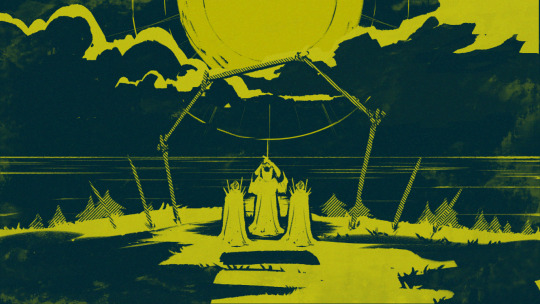
I have always found religious cults to be fascinating case studies in what happens when belief goes wrong - when faith is twisted by manipulation and deceit. Kitfox Games’ The Shrouded Isle is a game centered around this idea - a “cult management sim” where you attempt to steer a community towards the end of the world.
I was instantly captivated by the concept, and sat down with the Nintendo Switch version of the game for a look.
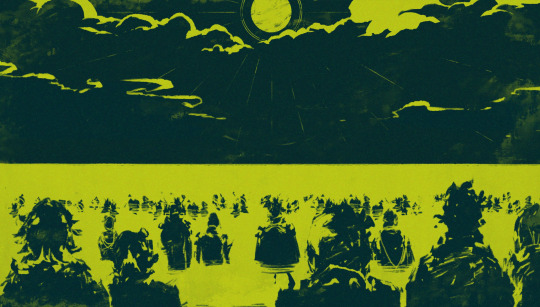
If you’ve played games like The Sims or Civilization, you may recall managing the happiness level of a population by making decisions and imposing edicts. Well, you’re basically doing the same here - just for a darker purpose. In The Shrouded Isle, the dark god Chernobog is set to rise from the sea in a mere three years, bringing about the end of the world. You must prove to Chernobog that your cult is worthy of his tentacled embrace.
To do so, you must direct your cult in their worship of Chernobog. The functioning state of the cult is measured by their ignorance, fervor, discipline, penitence, and obedience. The “quantity” your cult has shown in each of these factors is displayed in a set of meters on the screen, along with a threshold you need to meet for each. If a factor drops below the threshold for too long, you’re in trouble - the cult may dissolve, and your formerly devoted cultists may arrive at your door with torches and pitchforks.
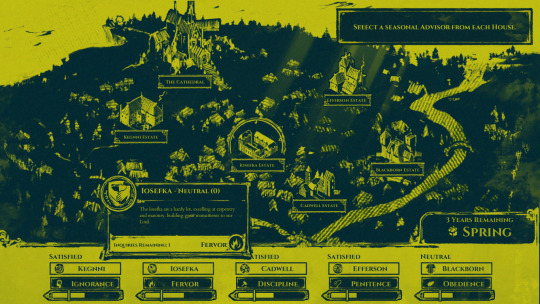
Your cult is made up of five families, each in charge of ensuring that one of the factors is met. If a family is happy, their corresponding meter will rise. If not, well.. You don’t want a family to rebel. It doesn’t end well. How do you make them happy? Make decisions that favor that family over the others. Of course, favoring one family tends to harm the other families.
Each month over the three years, you must choose one to three advisers from these five houses to help you lead the community. Their actions can raise or lower each factor. Each member of a family has a virtue and a vice - traits that grow or reduce meters. For instance, one person might enjoy burning books - raising ignorance. However, they may also have a secret - they like to steal at night - lowering discipline. These factors tend to not be in proportion. If the rise in ignorance is high enough, you might choose to ignore the drop in discipline. However, if it goes the other way, they may be a poor choice of adviser.
Of course, you don’t go in knowing these things. Part of the gameplay loop is discovering the virtues and vices. At times, you’ll get to ask questions - this allows you to quantify the impact of their traits. However, even this is not always wise, as asking questions lowers that family’s happiness.
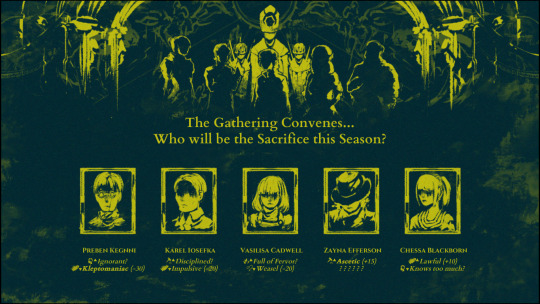
Chernobog is not a happy, loving sort of god. Each month, you must make a sacrifice. When the month ends, you need to choose an adviser to kill. Ideally, this should be one whose vice far exceeds their virtue. However, again, you need to be careful - killing one of their family members tends to hurt that family’s impression of you as a leader. If their crime is not all that severe, you could get in trouble for getting rid of someone that you simply don’t like.
Naturally, those who worship Chernobog don’t tend to be all that... sane. At times, mental diseases will override a person’s virtue, turning it into another vice. You have a way of dealing with this too. You can imprison the diseased in a dungeon, locking them away for a month or more. During this time, you can attempt to purify them. Purification doesn’t always work. It can mutate their virtues or even worsen their disease. You can examine them first, improving the odds of success, but this requires locking them away for an additional month - not always a wise decision.
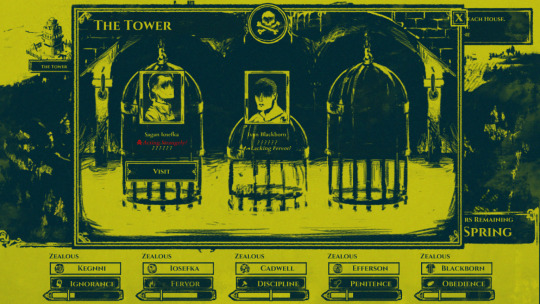
That is the basic gameplay loop. Try to choose the right advisers to optimize the five core traits, and remain alive as long as possible. It isn’t an easy task - you must constantly make decisions, and there are no easy decisions to make. Everything you do carries a negative side, and surviving as the head of a cult seems to be a job with a high morality rate.
The Shrouded Isle as fascinating as a study in decision making. It isn’t a game about good versus evil. It’s a game where evil is a given, where morality is never in question. Instead, it’s a game about manipulation - about how to best abuse and kill in the name of a god, without finding yourself at the other end of the noose. This makes it incredibly interesting. The Shrouded Isle is a more effective piece of horror fiction than any Resident Evil. Nothing is waiting to jump out at you in the closet. There are no zombies around a corner. In fact, other than in dreams, there are few traditional monsters. Instead, you are the monster, and the horror revolves around the decisions made by zealous men.
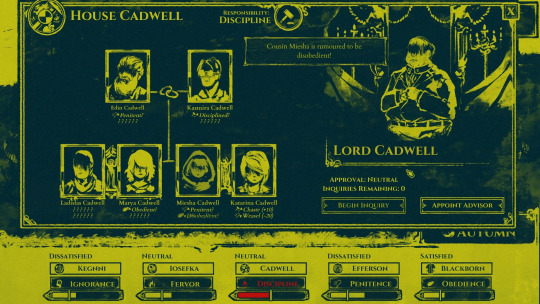
The themes of the game are supported well by the art direction. The Shrouded Isle is presented in two colors (which you can choose from a set of palate options). The default - a sickly green and yellow - creates this sickening feeling in the pit of your stomach that is backed up by the actual decisions you have to make. Most of the on-screen elements are hand-drawn, and the art is excellent. The combination of art style and limited color palate create a mood that really fits the proceedings.
As interesting as the game is, I also have to say that I am a bit disappointed in how little there is to it. The core gameplay is entirely focused around this monthly cycle - choose advisers, watch impact on meters, choose one to sacrifice. Occasionally, random events will ask you to make quick choices that also have an immediate effect on the meter. However, I wish there was more to it to flesh out this loop - perhaps the ability to build different structures, negotiations with other cults, something like that. I quickly reached a point where I was a little bored of the structure of the game, and felt that it was too basic. Others may get more out of it, but I don’t think that I’ll spend much more time playing.
The Switch version is also not an ideal way to play the game. This is a shame - this type of game should be great as a portable experience. However, the text is annoyingly hard to read in handheld mode. You can make it out, but expect some eyestrain. Hopefully, the developers will consider adjusting it in a patch.
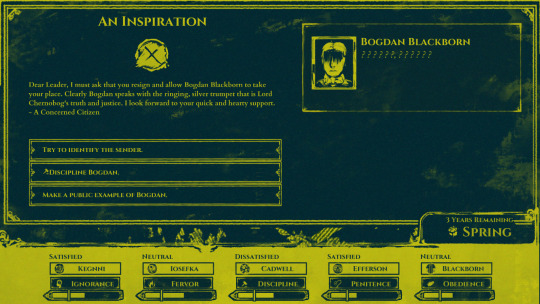
Despite a few caveats, I did find The Shrouded Isle to be a fascinating experience. I love the core concept of a game that is entirely about making difficult decisions, I love the art direction, and I love the Lovecraftian theme. If you find the concept compelling, I’d recommend trying it out.
A copy of the game was provided for this review.
Official Website
Nintendo eShop
1 note
·
View note
Text
4cr Plays - Nairi: Tower of Shirin (Switch)
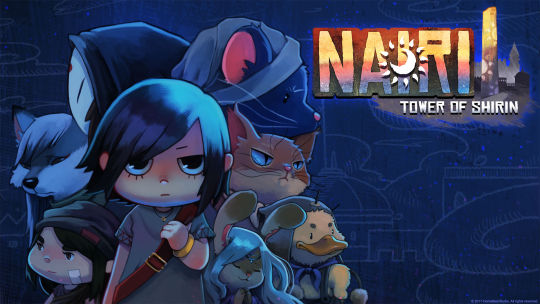
Sometimes, a game comes seemingly out of nowhere and worms its way into your mind. Nairi: Tower of Shirin is one of those games. I love indie games, but I don’t usually get excited about them in the way I did about Nairi after seeing that first trailer - especially for a the debut game from a two-person studio.
There was just something special about it - the art, the music, the general mood of the setting - that captivated me. I’ve been interested in it ever since.
Well, the wait is over - Nairi launches this week on PC and Switch. Read on for my impressions.

The story of the game follows the titular protagonist, a upper class girl smuggled out of her home town after her parents are arrested. Her quest to reunite with her parents draws her into an ancient mystery, and her fate becomes intertwined with surprisingly friendly bandits, criminal ducks, and the rest of the quirky characters that live around the tower of Shirin.
Nairi is a point and click adventure game, where you explore a variety of 2D landscapes in first-person, solving puzzles to advance. Like most adventure games, you will have to click around - go on a pixel hunt - to find the items needed to solve whatever puzzle is in front of you. You often then need to combine items. For example, in one early scene, a duck asks for something cool in exchange for letting you go down an alley. To get through, you need to collect a hat, feed lollipops to some goons, collect the sticks, then glues those sticks to the hat. Was the assembled mess actually cool? That’s questionable, but the duck liked it well enough.
If you’re an experienced adventure fan, none of the puzzles are sadistic head-scratchers. Still, they require that you pay some attention and think forward - especially when you need to start flipping switches in a certain order. The Switch version offers a variety of control options. You can use the analog stick to move a pointer around the screen, you can aim the joycon like a pointer, and you can use the touchscreen. I primarily just used the analog stick. The pointer controls were too finicky, and the touchscreen requires more pixel hunting - the pointer changes shape if you’re over a clickable item, while touchscreen use lacks an on-screen pointer.

I loved Nairi, and had a great time working through it. This isn’t actually because of the gameplay - I didn’t find the core gameplay loop to be incredibly compelling. It’s functional, but not the main draw. Instead, it’s everything else that drew me in and captured my attention.
Let’s start with the art. Everything on screen in Nairi is hand-drawn by HomeBearStudio’s artist You Miichi. The style is hauntingly beautiful. Every character and scene is distinct, and it all merges together to create an incredibly memorable setting. Combined with generally good writing, every conversation and character is memorable, and every encounter feels important. The music, similarly, brings scenes to life.

The entire experience reminds me of the Professor Layton games, actually. The world of Nairi is fully-realized and compelling - moments of humor are followed by a feeling of dread, or a note of melancholy. I really want to avoid spoiling much, but I felt a connection even during early moments in the game - like when Nairi separates from a gang of bandits that she had befriended - that tugged at the heartstrings.
I love the cast of Nairi, and I loved the setting - the beautiful back alleys and ancient temples of Shirin. The presentation - the colorful, richly detailed art, the gentle, melancholy tone of the soundtrack, and the charming script - sucked me in and captured my attention.
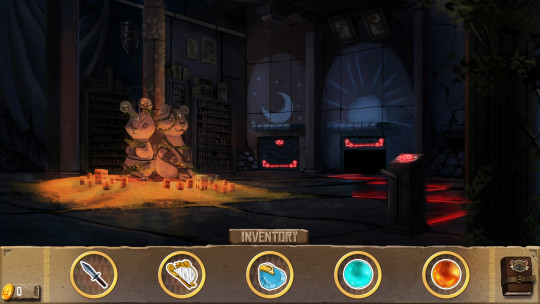
The game is relatively short - probably about four to five hours for most players - but feels about right for the story they tell. The pacing feels appropriate, and the gameplay does not outstay its welcome. It turns out that this is the first entry in a planned series, and I genuinely hope that it sells well enough that we get to see more of the setting that the studio has built here.
I think that HomeBearStudios has something special here. This game is beautiful and haunting in a way that few are. With a few gameplay tweaks in future entries - some refinement of controls, a little less backtracking - future entries could be pretty remarkable. If you are interested in adventure games, or looking for a memorable story-driven experience, I highly recommend checking it out.
This review was based on a code provided by the publisher, Hound Picked Games.
Nintendo eShop
#video games#review#Switch#Nintendo#Nintendo Switch#eShop#indie#Nairi#nairi: tower of shirin#homebearstudio#greg4cr
2 notes
·
View notes
Text
4cr Plays - Persona Dancing: Endless Night Collection (PS4)
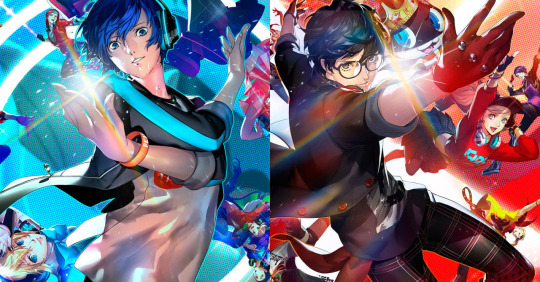
It’s a testament to the strength of the casts in the Persona series that its characters can appear in spinoffs in so many disparate genres and feel like naturals. Fighting game? Sure, they can duel each other to submission. First-person dungeon crawler? That’s basically what they did already, from a new perspective. Dance off? Why not?!
The last one is our focus today. A couple of years back, the Persona 4 cast took to the stage in Persona 4: Dancing All Night. Despite the absurdity of the core premise - the investigation team must dance to protect missing idol singers from monstrous shadows - the game was a delight. It was pure fanservice, but damn, I adore those characters and that soundtrack. I’ll dance the night away with Chie and Rise any day of the week.
Now, Atlus has returned to the rhythm genre with a pair of games applying the same formula to the soundtrack and casts of Persona 3 and Persona 5. Persona 3: Fancing in Moonlight and Persona 5: Dancing in Startlight launch this week on PS4 and PS Vita - either separately for $60 each or in a dual pack - with a PS4 version of Persona 4: Dancing All Night - for $99.
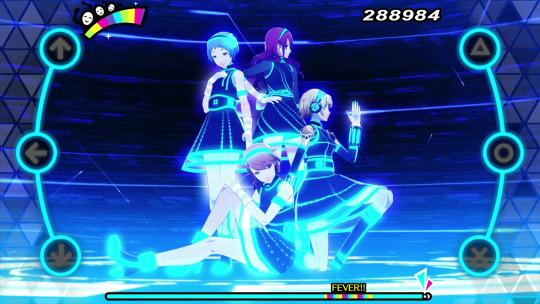
I should start off my impressions with a disclaimer. I am not a big fan of rhythm games. I love music, but I am basically tone-deaf and have the reaction times of a pineapple. I suck at games that require matching any sort of beat. I am, however, a massive fan of the Persona series. So, this review is going to be from that perspective more than a look at the games as a fan of the rhythm genre.
That said, the gameplay of the Persona dancing games is thoroughly in the vein of something like Dance Dance Revolution or Guitar Hero - pressing the right buttons in time with the notes. Basically, as you work through a song, notes will stream from the center of the screen to the edges. You must press one of six buttons as the note nears the edge of the screen - the down, left, and up buttons on the d-pad and the triangle, circle, and X buttons on the right. When the note lines up with a circle on the edge of the screen, press the corresponding button.
There are also a number of special notes that require some more effort. Some note must be held - press the button in time and keep it down until indicated. Others require two buttons to be pressed simultaneously. The last element are the “scratches”. When these circles near the edge of the screen, you need to flick one of the analog sticks (scratches can also be mapped to the triggers). The scratches are important, as hitting the right ones will activate a special “fever mode” - where a score multiplier is activated, and where you can save yourself if you’ve been falling behind.
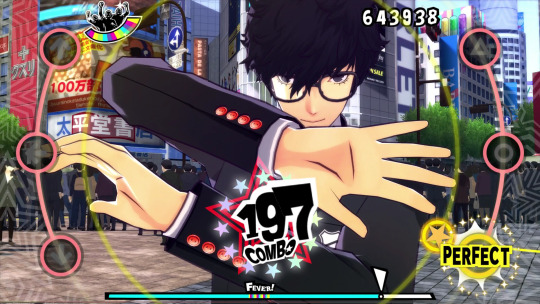
Scoring is based on how well you landed notes, ranging from perfect, to very good, to good, and to a miss. Too many misses, and you’ll fail the song. At the end, the number of hits in each category and your combo will determine your final score. An early miss will harm you less than a miss at a critical moment that breaks a long-running combo. Keep in mind - “good” ratings are a hit, but will also break a combo. You need to make a lot of “perfect”s and “very good”s to top the boards.
This is the same basic formula at the heart of Persona 4: Dancing All Night (P4D). As a rhythm outsider, I don’t think there have been any fundamental changes - if you liked it there, you’ll be fine. If you hated it, I doubt this will change your mind. For my part, I think it works well. The controls feel responsive enough. There are multiple difficulty levels - higher ones up the speed and number of notes. I tended to stick to “normal”, and did just fine. I didn’t go near the higher difficulty levels, but know some fiends will work to master the highest tiers. I wish them, and their superhuman reflexes, the best of luck.

Of course, the attraction here is definitely the music. The Persona series features some of the best soundtracks in gaming. The great part too is that those soundtracks are quite different. The music in Persona 3 is vastly different from that in 4 and 5, so the experience feels fresh across games. That said, splitting the soundtracks over games makes each feel a bit thin. Some of the same basic songs appear multiple times, with remixes and live versions. As a result, the tracklists seem a bit thin. Few songs are true duds, but I didn’t care for some of the remixes.
Still, the soundtracks are great, and the presentation is top-notch. Both games look great - clean, colorful, and sharp. I realize that creating the sets for a rhythm game is a smaller task than creating a full explorable world, but seeing all of the Persona 3 settings recreated in HD really made me wish that Atlus would remake P3 and P4. This is the sharpest, cleanest presentation of these settings and characters that have existed. It can be a little hard to tell what is happening on screen at times, with all of the effects in full blast. However, this is definitely a fun game to watch. It’s a visual treat.
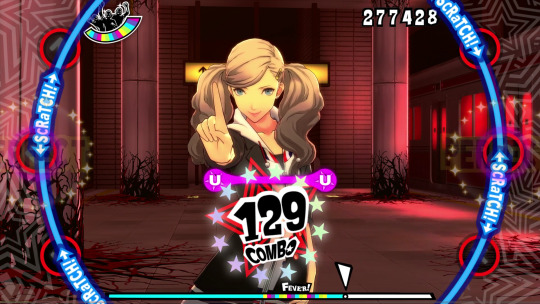
A number of factors can be customized during dancing. There are track modifiers that can be enabled to make the experience either easier or harder. For example, one modifier prevents “good” hits from breaking a combo. However, the modifiers that make playing easier will cost you points. Other modifiers make the experience more devilish. You can also outfit dancers in a huge variety of outfits and accessories - from wigs, to glasses, to headphones. The more you play, the more clothing options you can unlock. After the first playthrough, you can also select different dance partners. Both costumes and the backup dancers are pure fanservice, but some Persona fans will have fun playing with different options.
P4D had an extensive story mode to supplement the core dancing. A lot of people found the story mode boring, but I really liked it. I love the Persona 4 characters, and thought the story was an interesting look at the issues with idol culture in Japan.
Sadly, the two new games have both dropped the story mode entirely. Instead, a basic “it’s a dream” framing device is used to justify the dancing, and that’s about it. Instead, checking off requirements in the dancing mode will open up “social link” scenes with the individual cast members. These are fun little fully-acted vignettes, and progress a bare-bones overall plot. Later scenes let you explore each character’s bedroom. If you have a PSVR, you can activate it and walk through each area in first-person. As a fan, these scenes are cool. I love spending a little more time with both casts. However, you definitely notice the loss of a dedicated story mode. The scenes feel inconsequential without any central driving plot - just a bonus for fans of the series.
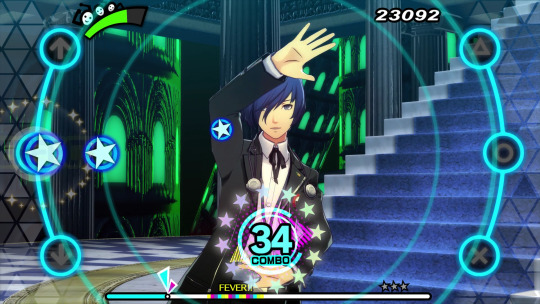
Ultimately, your enjoyment of these games will depend on how much of a Persona fan you are. The soundtracks are incredible, the dancing is fun enough, and the presentation looks great. However, the experience is thin on content, especially at full price. I’m not sure I could recommend either game at $60 each. These feel like budget releases tossed out at full price, and should have just been one game from the start. The $99 collection has more merit - especially since it includes a PS4 version of P4D. Looking at is as $33 per game, it doesn’t seem bad at all. If you’re a fan of the series as a whole - if you love those casts and the soundtracks - the full collection may be worth your time. If you aren’t already a Persona super-fan, I don’t think there’s as much to recommend at the high cost of entry.
This review is based on a copy provided by the publisher, Atlus.
Official Website
1 note
·
View note
Text
4cr Plays - 7 Billion Humans (Switch)

As you are, no doubt, aware, video games are created by writing thousands-to-millions of lines of code in a programming language - a structured collection of commands that tell a computer what to do. Games are some of the most complex programs we write. They are these beautiful bundles of barely-contained chaos - hundreds of classes, collections of functional elements, working together to launch that princess-saving plumber over the fiery pit.
Yet, despite games being made of code, few games are about code. 7 Billion Humans - an expanded sequel to Human Resource Machine - is a fantastically addictive puzzle game where challenges are completed by creating programs.
Read on for my impressions.

Ostensibly, 7 Billion Humans is a game about getting people to do what you want. Each stage places you in an office, gives you a goal and a set of workers, and tasks you with creating a script - a series of commands - that will direct the workers to complete that goal. For instance, you might have to direct the worker to walk until they see a box, pick up the box, walk until they find a line of boxes, then find empty spaces in that line to drop their boxes.
You construct these scripts out of a series of commands, similar to those used in programming languages. Take that first step - walking. You may know ahead of time that the boxes will not be behind the workers. In that case, you could provide a “walk” command, noting that they should walk forward. Now, to pick up a box, you simply use a “pick up” command. Pretty simple, right?
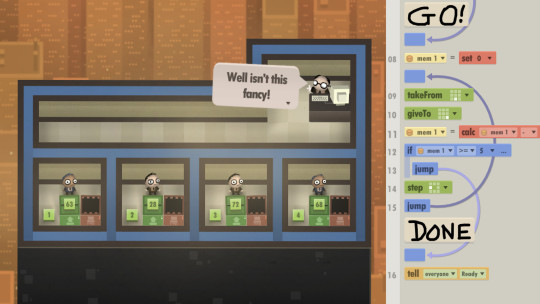
Well, you may have noticed that you have to know that there is a box to pick up. There will not always be one there when you step forward. In that case, you need a way to recognize that a box is present. The “if” command is needed to handle such situational behavior. You could drop in a command that says that if there is a box in front of you, you need to pick it up. Following the “if” is the “else”, where you indicate what to do if there is not a box. In this case, you might want to take another step forward. What if the box is not in this row either? Well, you can place a “jump” command to rerun a block of code. Loops can be used to repeat a set of actions a specific number of times as well. New commands and elements are also added in periodically throughout the game to keep things fresh.
Unlike most programming environments, you do not have to actually type programs. Instead, scripts are constructed in a drag & drop visual programming environment. This is very similar to the Scratch environment often used in introductory programming education. You create a script, click run, and watch your workers do their job. You can also walk through a script step-by-step to debug errors.
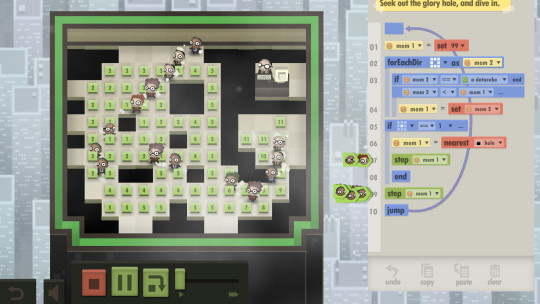
Writing a program is often compared to solving a puzzle, and 7 Billion Humans does a brilliant job of taking the essence of software development and turning it into a really fun game. I am a software engineer myself, so I may be predisposed to enjoying this game, but there is just something incredibly satisfying about solving these challenges. Some of the puzzles are fiendishly difficult, even for someone who programs on a regular basis. If the regular game isn’t difficult enough, there are also optional goals for the speed of program execution and the number of commands you use. Most developers know that tour first solution is rarely the simplest or fastest, so the game gives you targets to try to beat.
7 Billion Humans is that rare sort of game that is both fun and actually educational. Solving puzzles requires a certain mindset - it encourages planning, experimentation, and critical thinking. If I were a parent, this is the exact sort of game I’d encourage a kid to play. It might actually be a nice thing to play if you are preparing for a coding interview as well.
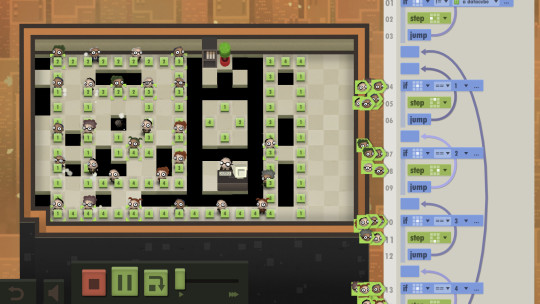
I’ve been playing 7 Billion Humans on Switch, and my main complaint is that I wish it had traditional button controls. You can either use the touchscreen or use a joycon as a pointer. However, I usually play this in bed, so the touchscreen is the only practical option. I don’t know if a mobile phone or tablet version is in the works, but those might be better alternatives for portable play. That said, the touchscreen works - it’s just clunkier on Switch than it would be on something like a phone. The game runs well, and although I’m not a huge fan of the art style, I have no complaints about the general interface.
If you’re looking for a puzzle game, have some interest in programming, and want something to get your mind spinning, I highly recommend checking out 7 Billion Humans. I really enjoy how it turns programming into a game, and expect to dump a fair amount of time into meeting those size and speed goals.
A review copy of the game was provided for this review.
Official Website
Nintendo eShop
1 note
·
View note
Text
4cr Plays - Faraday Protocol (Switch)

Faraday Protocol is a first-person puzzle game centered around an archeologist, Raug Zeekon, from the planet Cunor. Raug has been sent to investigate a mysterious signal. Shortly after arriving at a set of mysterious pyramids - called OPIS - Raug stumbles on the "Bia Tool" - a gun that can absorb and expel energy. He must use this tool to navigate a series of increasingly-complex circuit-based puzzles and to uncover the secrets of the OPIS complex.
I sat down with the Switch version of Faraday Protocol. Read on for my impressions.
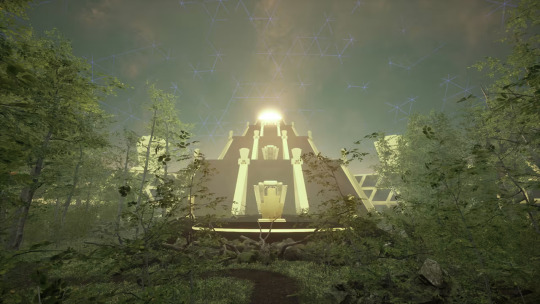
Although I led in with a description of the plot of Faraday Protocol, the story isn't all that detailed or important. It is mainly there to serve as the connective tissue for the game itself, which consists of a series of puzzle rooms connected together as part of archaeologist Raug's exploration of an alien temple complex.
As I mentioned, Faraday Protocol is a first-person puzzle game. Like in a first-person shooter, the camera is placed in Raug's head, and you navigate the environment from his viewpoint. However, rather than using your "gun" to shoot enemies, you use it to interact with your immediate environment in order to open a path forward to the next area.
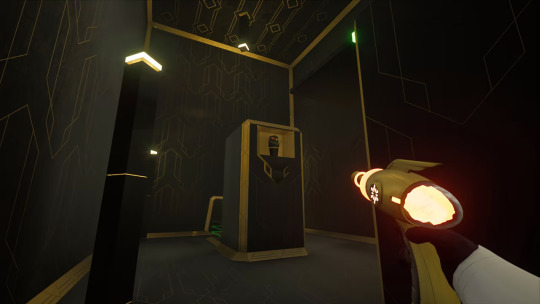
This gun, the "Bia Tool" is able to absorb energy from small statues - essentially batteries - and redistribute that energy into other statues. This energy can come in two colors, orange and blue, and is mostly used to power items in each room. This energy can open doors, move platforms, and activate increasingly-complex Rube Goldberg machines. Often, solving puzzles is not a matter of activating a single switch, but in triggering sequences of small steps that ultimately allow you to open the final door in an area.
You can think of these puzzles as circuits that you need to complete by manipulating them one piece at a time. In some cases, this is quite literal - the "blue" energy can be used as a chain that connects two sockets, creating an actual circuit. In others, this is more of a figurative circuit - moving energy through a series of connecting gates, small puzzles that you complete in sequence.
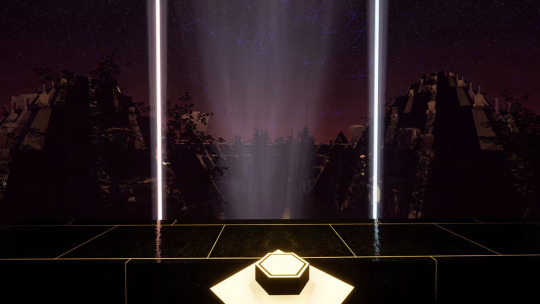
In some ways, Faraday Protocol is very reminiscent of Portal. A game where the mechanics of a shooter are used as a means of interacting with a complex environment. Like Portal, your enjoyment of Faraday Protocol will largely come down to how much you enjoy engaging with these environmental puzzles. The puzzles get quite complex, eventually spanning down several rooms and hallways. The game can get quite difficult in places, but it's also quite clever and feels very satisfying when you finally pull at enough threads to solve the later puzzles.
Faraday Protocol is not an incredibly long game. I think it took me about five hours to complete. This felt about right. Any longer, and I think it would have begun to outstay its welcome. This is also not a game I would recommend binging through. I ended up enjoying it in small, 20ish minute chunks. Essentially, I would complete one puzzle at a time and stop if I found myself scratching my head too much. Several times, I found myself slightly overwhelmed, put the game down, and came back later to immediately solve a puzzle.

The art direction in Faraday Protocol is quite interesting. The art style itself is fairly realistic, but the setting you explore heavily blends elements of ancient Egyptian art and an Art Deco retro-futurism. The pyramids are filled with black and gold hallways, with huge statues and pillars. It's a cool look. In some ways, I wish that the developers had gone even more over-the-top - perhaps something a little more stylized and less realistic - but it works well at providing you with an interesting environment to explore.
I played through the game on Switch, entirely in portable mode. It worked well. Looking at screenshots of the game on other systems, it is clear that the Switch version is missing some detail and some of the visual effects, but it still looks fine. The controls work well, and I didn't have any major difficulties with interacting with even small items in the environments. I also didn't have any major performance issues that I noticed.
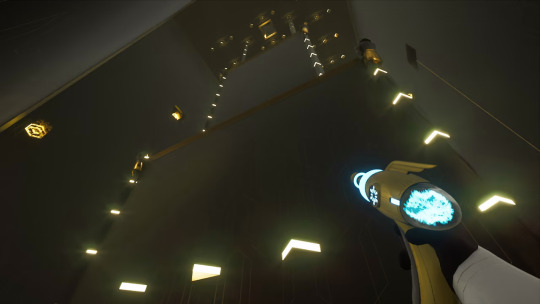
If you are interested in a new puzzle game for the Switch to tease your brain, Faraday Protocol is worth considering. It presents some interesting mechanics and satisfying puzzles, and is about the right length to allow its core mechanics to shine without overstaying its welcome.
A copy of the game was provided for this review.
Official Webpage
Nintendo eShop
0 notes
Text
4cr Plays - Sam & Max: Beyond Time and Space (Switch)
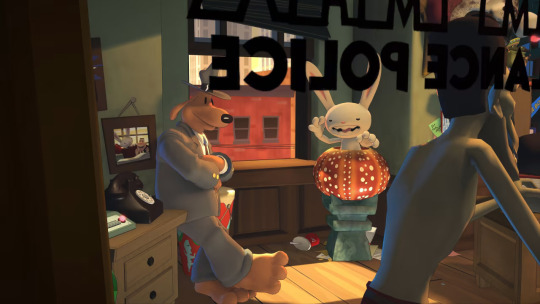
I've always had a soft spot for the Sam & Max series - point & click adventure games about a canine detective and his best pal, a megalomaniacal rabbity thing. I played the original, part of the legendary LucasArts lineup of the 90s, over and over again. Then, when Telltale Games brought back the duo as the stars of three "seasons" of episodic games, the episodes became part of a ritual where my future wife and I would sit around a CRT computer screen on Friday nights and play through them. I have really fond memories of playing each episode as they came out.
After Telltale closed down a couple of years back, a group of former developers - under the banner of Skunkape Games - bought the rights to the original games. These developers have been working to release all three seasons on modern systems, with a huge range of improvements to the controls, graphics, and audio. The remastered first season, Sam & Max Save the World, was release last winter - where it made the first winter of lockdown a tiny bit more bearable.
Now, one year later, the second season - Sam & Max: Beyond Time and Space - has been released on PC, Xbox, and Switch. I have spent some time with the Switch release. Read on for my impressions.
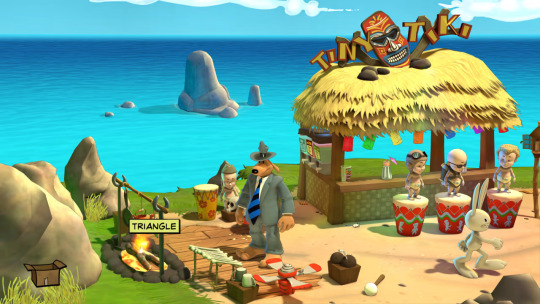
Sam & Max: Beyond Time and Space is a "point and click" adventure game. What this means, essentially, is that you progress through a story by solving puzzles embedded in an environment that you explore. That is - you point at things on the screen and click on them to interact with them. Your character has an inventory of items, and can use those items as part of manipulating your environment to progress.
In this type of game, the puzzles are the core focus of the gameplay. Timing isn’t particularly precise or important, and you don’t need to memorize button combos. Instead, the goal is to get you to stop and think - to reason using the tools at your disposal. One of my favorite examples of the type of puzzles and logic in this genre comes from the first season of Sam & Max. Early in the game, a rat in your office has stolen your phone and won’t return it until you offer up Swiss cheese. Max has filled the closet with cheese. This would be great, except that it isn’t Swiss cheese. Fortunately, your inventory holds the solution - Sam’s revolver! Swiss cheese has holes, a gun can make holes, perfect! You need to think a little outside of the box, and put on your Looney Tunes brain. However, if you can get into the right mindset, the solutions tend to click into place.
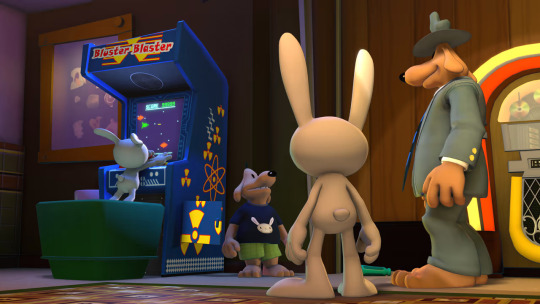
The story of Sam & Max revolves around the titular duo of "freelance police" - self-deputized crimefighters dedicated to solving mysteries and filling their wallets with sweet, sweet cash. Sam is a dog in a trench coat, and Max is a long-eared psychopath. Sam & Max: Beyond Time and Space is presented as a season of six episodes, much like a TV show. Initially, each tells its own short story. Our detectives face off against Santa Claus, investigate a giant volcano, and meet a sketchy vampire. However, each case begins to tie together, before concluding in the dramatic season finale.
As you can imagine from that description, Sam & Max is fully tongue-in-cheek - a surreal comedy that blends a bit of Looney Tunes, a bit of Calvin and Hobbes, and a touch of Far Side. It is a world where animals and humans freely interact and it isn’t particularly weird to shoot the cheese with a gun. It is delightfully hilarious. Even today, I feel compelled to click on every single item just to see how it was described and every single dialogue option. Few games have comedy writing this sharp and hilarious, and this game is worth experiencing just for the script.
Each episode lasts about an hour and a half to two hours. Back in 2007, one episode was released every 1-2 months. As a result, it was a pretty novel way to play a game. Rather than it being your focus over a week or two, you would play it in these bite-size chunks. For many games, this kind of format doesn't make much sense. However, here, it worked well. It created a unique pace, and kept the game from becoming boring or overstaying its welcome. As I mentioned, I used to have a bit of a ritual with Telltale’s games, where I would play through a new episode on a Friday evening with my girlfriend (and future wife) around the old computer.
The remaster presents you with all of the episodes at once, so you don’t have to space each episode out. However, I absolutely recommend that you do. It's a different and refreshing pace compared to games that you just binge. You don't need to wait a month between episodes, but it was fun to play an episode every week or so in the remaster.
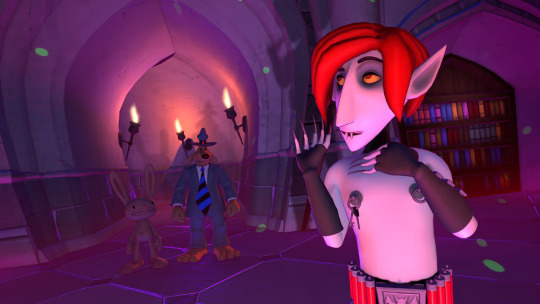
If you played this season of Sam & Max back in the day - and your brain actually functions, unlike mine - you might be wondering what has changed in the remaster. The obvious thing is a redesigned control scheme for playing with a gamepad instead of a keyboard and mouse. The driving and shooting, in particular, have been tweaked.
The original game was not designed for controllers from the start, but the new controls feel fairly natural. I have been playing on the Switch, and haven’t missed the mouse-based interface of the original release. How it works now is that you walk through the environment with the left stick, and use the right stick to target different objects for interaction. Rather than hunting for an object, you can use the right stick to switch between all of the nearby options. This works well, and nicely deals with a common adventure game problem of having to hunt for more interaction targets.
Accessibility options have also been added, including the ability to skip driving minigames and a toggle to turn off lighting effects that could trigger seizures.

There have also been many improvements in terms of graphics and audio. In addition to the resolution being increased, the assets have been scaled up, and dynamic lighting and shadows have been added. The character models have been tweaked, based on input from Sam & Max creator Steve Purcell's feedback. Visual effects have been added that were not possible in the Telltale engine back in 2007, including falling snow at the North Pole. The camera angles, character acting, and choreography have also all been adjusted by cinematic artists. The game looks nice, thanks to the visual overhaul. I have played on the Switch, and have had no issues - the game runs well and looks nice on either the TV or the tablet.
The audio in the original version was compressed to limit download sizes. The developers have collected the original voice actors and re-recorded their lines at a higher quality. The soundtrack was also re-recorded using live musicians, and new tracks were added by the original composer, Jared Emerson-Johnson.
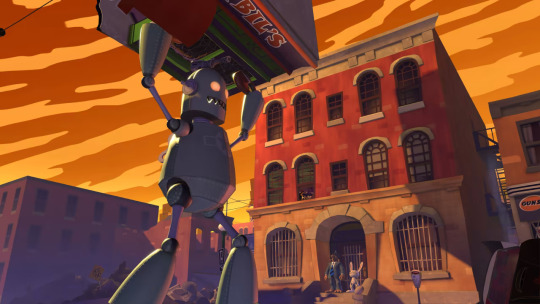
It's an impressive effort. This is a ton of work, when many remasters simply add higher resolutions and widescreen support. It really shows the passion of the developers for their creation, and is worth supporting.
Beyond these tweaks, the game itself still holds up well. The puzzles are clever, but not punishing, and you don't need an advanced degree to solve them. The writing is still genuinely hilarious, although some of the jokes definitely place the game right in a particular time and place. Both of the remastered seasons of Sam & Max are worth revisiting if you haven't gone back to them in years or playing now for the first time.
Official Webpage
Nintendo eShop
1 note
·
View note
Text
4cr Plays - Valkyria Chronicles 4 (PS4)
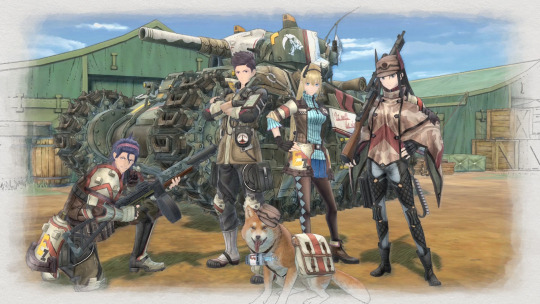
Valkyria Chronicles 4 tells the story of Squad E of the Ranger Corps of the Atlantic Federation - the “Allies” embroiled in a war with the Eastern Imperial Alliance over the future of the continent of Europa. As part of a desperate gamble to end the stalemate, the rangers have been sent deep into Imperial territory. Squad E, led by commander Claude Wallace and largely made up of a group of childhood friends from the town of Hafen, will fight to save their homeland, win the war, and - for the most part - just to survive to see another day.
I sat down with the latest chapter in SEGA’s strategy RPG series. Read on for my thoughts.
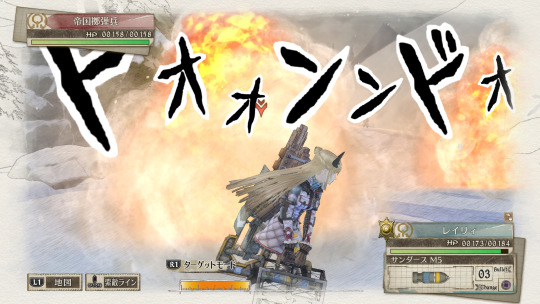
As you can probably tell from the brief description, Valkyria Chronicles 4 presents a thinly-veiled take on World War 2, filtered through a thick dose of anime-style storytelling. Set in the same world - and around the same time - as the first game in the series, Valkyria Chronicles presents an alternate take on our own history where an energy source called ragnite has led to rapid technological advances, and - of course - to war. As a result of ragnite, the world of Valkyria Chronicles is both familiar and not all at once. The general state of technology is behind what we are used to, but ahead of what our own world had during World War 2. Now, the Valkyria Chronicles series is not really meant to be an actual alternate take on real history - the country names are all different, there are people with actual super powers, and so on - but barring some of the fantastical elements, you can basically scratch out and substitute the names and have it all feel familiar.

Valkyria Chronicles 4 is a strategy game, presented in much the same manner as the recently remastered first game in the series. The story is split into a series of chapters. Each chapter consists of scenes that either advance the plot or ask you to take part in a battle. The plot scenes are told in a style similar to a graphic novel, with animated panels of characters talking.
Battles are turn-based. You are allocated a certain number of “command points”, which determine how many characters can be activated in a turn. When activated, a character can move around - limited by their pool of action points - and can attack. They can attack once per activation, but can continue to move as long as they have remaining action points. Characters can be reactivated multiple times per turn, but with a diminished pool of action points each time. Some types of ammunition are also limited. Movement takes place in a fully-3D plane, and characters can take advantage of cover for protection. Between activation, you get a map view of the entire battle with the positions of your soldiers and spotted enemies marked. If a character is taken out, you have three turns to get another soldier to them - summoning a medic. If you don’t make it in time, or if the enemy gets to them, they die permanently. As the commander, you can also spend your command points on support orders. Orders, for example, can be used to evacuate downed troops, raise attack, or heal a selected soldier.
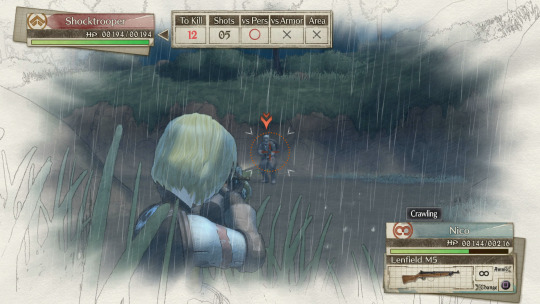
Between battles, you can select a set of soldiers to form your active and reserve rosters. At the start of battle, you get to choose a limited selection from the active squad to enter battle - based on the constraints of that mission. Soldiers come from a set of six classes. Scouts have a massive movement range, but can’t take too many hits before dying. Shocktroopers deal massive damage to ground troops, but have a much more limited movement range. Lancers are near-useless against enemy troops, but their powerful explosives can take out armored machinery like tanks and troop carriers. Engineers are a support class that can fix vehicles, repair cover on the map, restock ammunition, and revive fallen troops. Finally, grenadiers - a new class - can fire long-range explosives at unsuspecting foes. The downside is that they are slow to move and need time to set up, potentially placing them in danger.
As I hinted at, you also get access to a small number of vehicles. Claude, the squad commander, drives a tank. Tanks can fire powerful explosives, mortars, and machine guns. They can also take quite a beating before being destroyed. Later, you also gain access to an armored personnel carrier that can move a small number of troops across the map and an additional tank that can be equipped with weapons like flamethrowers. You also gain access to a battle ship that can assist by bombarding part of the map or using its radar to reveal enemy locations.
You have a limited number of spots to fill at the start of each battle, so careful selection of soldiers is crucial. Some maps require speed, making the use of scouts crucial. Others will railroad you through trenches while you are under bombardment, requiring a slow approach and armored units. You must pay attention to mission briefings, and some maps require a bit of trial and error to get through.
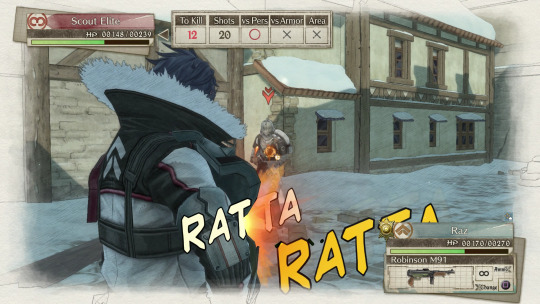
At the end of a battle, you get ranked based on your performance, with better rewards for better ranks. You can repeat battles to try to get a better ranking. Largely, I found that rankings are based on the number of turns you took, offering an incentive for quick completion. Early on, this can be accomplished by throwing scouts at everything. However, that quickly stops being a viable strategy.
Completion of battles earns you experience points and money. Experience can be used to level up troops, and is spent by-class, meaning that leveling up “scouts” will increase the capabilities of all of your scouts. Money can be spent on new weapons and tank parts. Some battles will reward you with special weapons, and each soldier can be equipped independently of the others - allowing some variation within classes. You can also earn additional experience and money through repeated completion of skirmishes - repeatable battles.
Each soldier has their own quirks - called “potentials”. These potentials are activated contextually, and can be positive or negative. For example, some soldiers are afraid of messing up in front of women, and will miss because they tried to fire in front of a female squadmate (yes, some of these are pretty cringe-worthy). Each soldier has a few particular squadmates that they like working with, and might get an accuracy or damage boost if they are near a friend. You can also unlock special side stories by choosing the right combination of troops.
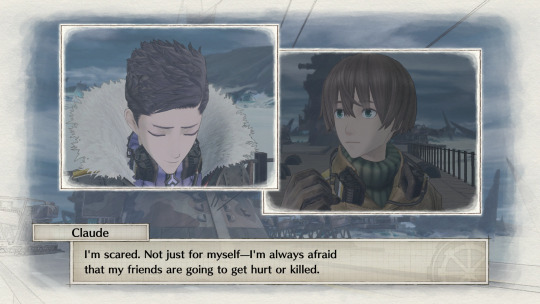
Valkyria Chronicles 4 is a beautiful game. Like the original, it utilizes a colorful cell-shaded art style that looks very crisp and clean. The character designs are distinct and memorable, and I dig the vehicle designs. The music and voice acting are also great as well. I played the game on the PlayStation 4, and it looks very nice on a big TV. It is also available on PC, Xbox One, and Nintendo Switch. I have not tried it on other platforms, but the performance is quite smooth on PS4. A demo is available on every platform, and progress transfers to the main game.
If you have tried and liked the demo, I have good news for you - there is a lot of game to play through. Valkyria Chronicles 4 is a very long game. Some chapters have up to three battles - each taking upwards of an hour - and often an hour or so of story scenes. My estimation would be that the core storyline takes about fifty hours to complete, not counting any of the side content.
Overall, I’ve quite enjoyed my time with the game. The battle system is very fun, and requires a bit of thinking to get through (assuming you want to get a decent rank). Some of the longer battles, with multiple twists, are exhilarating to work through.
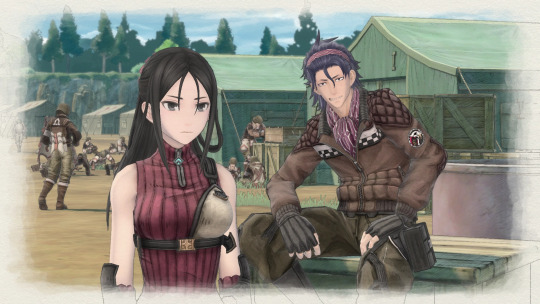
I am not quite as enamored with the storyline. It isn’t offensively bad, but I never fell in love with the characters. Ignoring a few exceptions, most of the cast is either kind of unlikable or a boring stereotype. In general, I feel that the original Valkyria Chronicles had a better cast. The other uncomfortable story-related factor in Valkyria Chronicles 4 is that the fanservice has been ratcheted up to an annoying degree. Women are battling in miniskirts and have huge floating breasts in cutscenes, characters regularly comment on their friends’ asses, and an early scene features one character just casually groping another character. In fairness, they get their ass kicked for it. Still, the fanservice is a bit much, and just makes me roll my eyes.
Still, Valkyria Chronicles 4 is worth a look. It expands on the earlier games in smart ways - like the new grenadier class. It does an excellent job of increasing difficulty over time and adding to your arsenal without overwhelming you. The battles are incredibly fun, and the game is a feast for the eyes. If you enjoy strategy games, I absolutely recommend giving it a try.
A review copy was provided by the publisher, SEGA.
Official Website
1 note
·
View note
Text
4cr Plays - Gleylancer (PS4)

We live now in the era of the remaster, where older games are released for new audiences with a fresh coat of paint - often updated to appear sharp on an HD display. Often, this treatment has been applied to games that came out one or two generations ago, bringing early 3D games into the modern era.
Advanced Busterhawk Gleylancer is an interesting outlier in this trend. This 1992 shoot-em-up was originally released in Japan for the Sega Mega Drive/Genesis, and did not make it into other parts of the world until 2008, when it appeared on the Wii Virtual Console. Even then, the surprisingly-long story scenes were in Japanese.
Now, Ratalaika Games has re-released Gleylancer on basically every modern system - translated into English, and with HD visuals.
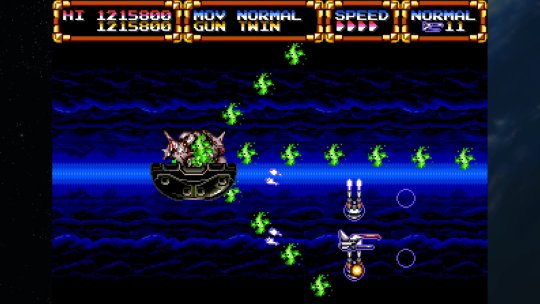
The plot of Gleylancer follows Ensign Lucia Cabrock after the outbreak of war between humans and an alien fleet in 2025. Lucia's father is captured by the aliens, and she sets out to rescue him with a hijacked prototype fighter - the titular Gleylancer.
Honestly, the story doesn't really matter as anything other than mild motivation for the gameplay. Gleylancer is a horizontal shoot-em-up in the vein of something like Fantasy Zone. You can move your ship freely in any direction in a 2D plane, and can attack the enemy ships with your guns. If you get hit, it's lights out. You can gain a little bit of protection, but to complete the game, you will need fast reflexes.

The Gleylancer can move at four different speeds, as toggled by the player. You can switch between different weapons by picking up pods dropped by enemies. These weapons include a basic gun that fires double blue laser pulses, a weapon that fires twin piercing laser arcs, one that shoots an arc of five purple pulses with good range but low fire rate, one that shoots fireballs, and more.
You can acquire up to two weapons at once. Both will be of the same basic type, with subsequent weapon pick-ups overwriting both. However, you can choose how these two weapons behave. In the normal mode, both fire in the direction the ship is moving (though, they can be locked in a direction with a toggle). In the reverse mode, the guns fire in the opposite direction of ship movement. In search mode, the guns automatically aim at the nearest enemy. In the multi mode, each weapon swivels in a 180 degree arc on the top or bottom of the ship. In the shadow mode, the weapons imitate every motion of the ship at a short delay. Finally, in the roll mode, the weapons spin around the ship at 180 degrees from each other. This gives you a wild, spiral pattern with good coverage of the screen, but low accuracy. This enables quite a bit of customization of how you play, adding some fun and replayability to the game.

Gleylancer is a fairly short game - only 11 stages - but poses a decent challenge. A "rewind" feature allows you to quickly roll back from a mistake, if you want to try the game, but are concerned about it being too difficult.
I'm not a huge connoisseur of the shmup genre. I can't tell you all of the nuances that separate Gleylancer from other famous shooters. However, I did have some fun playing it. Beyond the gameplay, however, I have to say that Gleylancer is a feast for the eyes and ears. The pixel art in Gleylancer is gorgeous. The ships and monsters are detailed and interesting, and the artwork is crisp and colorful in HD. It looks fantastic. It sounds even better. This game has a killer soundtrack.
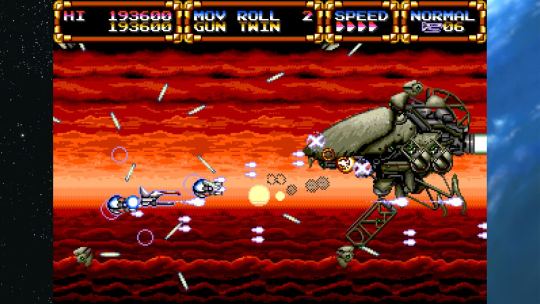
If you're looking for a shooter to play this weekend, Gleylancer is a great way to kill a few hours - and you might find yourself humming the soundtrack even longer.
A copy of the game was provided for this review.
PlayStation Store
Microsoft Store
Nintendo eShop
0 notes
Text
4cr Plays - Cosmic Star Heroine (Switch)

A secret agent, hackers, ghost detectives, slightly-too-friendly robots, and a galaxy-spanning conspiracy sound like the ingredients for a great weekend. They are also a few of the elements at the heart of Cosmic Star Heroine - an RPG from Zeboyd Games, the developers of Cthulhu Saves the World.
Cosmic Star Heroine launched last year on PS4, PS Vita, and PC, and hits the Nintendo Switch today. I’ve been excited to try Cosmic Star Heroine - a homage to old-school Japanese RPGs, blending elements of Chrono Trigger and Phantasy Star - and the launch of the Switch version offered the perfect opportunity to sit down with it. Read on for my impressions.
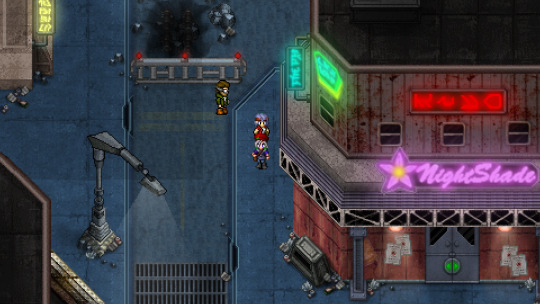
The story of Cosmic Star Heroine focuses on special agent Alyssa L’Salle, a rising star in the Agency for Peace and Intelligence (*ahem*... the API). The API are a police force that maintain peace in a galaxy full of psychic bugs, ghost detectives, hyper-intelligent tentacled cats, and - of course - a looming rebel threat. Before long, however, Alyssa discovers that the API are developing mind-control technology, and that they are not the force for good that she was led to believe. On the run, Alyssa must figure out who to trust and find a way to take down API before they can conquer the galaxy.
Of course, this is a tried-and-true plotline - the focus of hundreds of Science Fiction stories over the years. Fortunately, the creators of Cosmic Star Heroine know this as well, and aren’t taking the story too seriously. The game is packed with every reference and trope from the cyberpunk genre, but it is all tongue-in-cheek. The goal here is to send you out on a fun, exciting adventure, and they succeed quite well in accomplishing that.
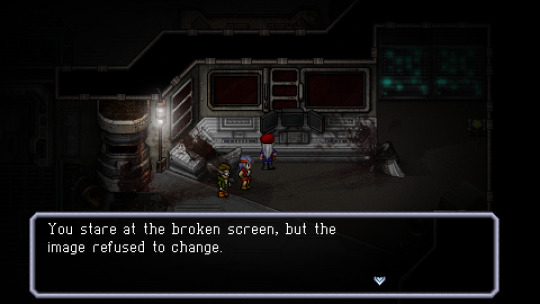
The characters in Cosmic Star Heroine are great. From Alyssa herself - an actual calm, capable woman of the type rarely seen in gaming - to Borisusovsky (er, Sue) - quiet, tough, with an excellent fashion sense - to Orson - a host detective straight out of film noir - the cast are charming and memorable. The high adventure feel of Cosmic Star Heroine is reminiscent of games like Chrono Trigger and Skies of Arcadia, lacking in moping self-doubt or deadly gravitas, and I genuinely had a great time working through the storyline.
The pacing helps greatly with that feeling. One of my favorite things about this game is the breakneck pace at which you move through it. This is an RPG that actually respects your time. As much as I enjoy spending a hundred hours in a Persona game, it’s really nice to have something that lasts a perfect fifteen hours or so. There is no filler, nothing designed to slow you down. Cosmic Star Heroine has a few side activities and optional dungeons to complete, but the main focus is on a well-designed, well-paced central plotline. It feels brisk, and no mechanic overstays its welcome.
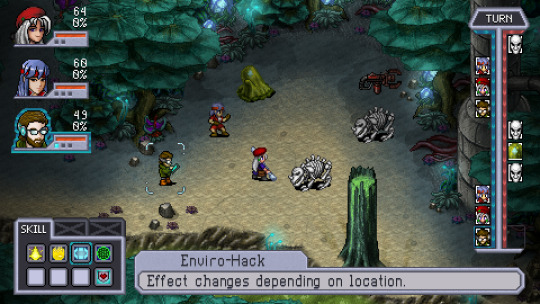
Cosmic Star Heroine is an RPG, so much of the actual gameplay consists of battles. You can see enemies on a field, so battles are not random. However, most battles are not optional. That said, once you defeat an enemy, it doesn’t return. In battle, each character takes a turn based on their speed - turn order is shown on the right side of the screen. Your main attacks consist of a series of seven abilities, which you can change outside of combat. Over time, each character learns about twenty abilities, so you have a lot of ability to customize each character. Characters can also equip various shields, which both boost your defense and grant additional abilities. You can change shields and choose the one that best compliments the native abilities of the character using it. You can also select a set of items to take into battle.
The key twist of the battle system in Cosmic Star Heroine is that abilities are gone after you use them until either the end of the battle, or until you spend a turn recharging. Shield abilities and items do not recharge, but do return in the next battle. Rather than being there to frustrate, the removal of abilities introduces a lot of strategic depth. Many abilities work best when you plan the order that you apply them in. For example, some abilities do more damage near the start or end of the battle. Others build off of other abilities. By taking away your ability to keep using one attack over and over, the game forces you to experiment. This means that you actually get to learn the battle system in greater depth than you might otherwise get to.
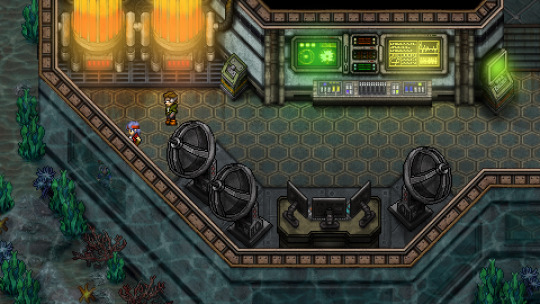
It is also a lot of fun to play with different combinations of abilities and characters. Certain characters tend to pair very well, and you get a lot of opportunity to try out different strategies. In fact, this is another area where the excellent pacing of the game comes into play. Characters are introduced throughout the game, and you typically must use them in your party for part of the plot. Rather than relying on a set team the entire game, you are forced to work with certain characters. Again, this is actually fantastic rather than frustrating. This means that you actually have to learn to use each character, and figure out how to work them into the overall party. I didn’t like every character, but I had a blast figuring out how to best use them in combat.
Visually, Cosmic Star Heroine affects a pixel-based aesthetic similar to SNES games like Chrono Trigger or Final Fantasy VI. I often think that pixel art is kind of uncreative and overdone in modern indie games, but the art in Cosmic Star Heroine is fantastic. The sprites are detailed, and there are a lot of great touches, like how Alyssa’s hair moves when running instead of walking. There is a lot of personality packed into each facet of each character and the overall environment. The general art direction, heavily inspired by Blade Runner, is beautiful and does a great job of setting the overall tone. There is a huge variety of environments to explore - aiding the feeling of going on a grand adventure. The soundtrack also heavily evokes Blade Runner, and is a pretty good impression of Vangelis’ work.

Cosmic Star Heroine is a brilliantly-paced, clever homage to old-school Japanese RPGs. I highly recommend it. I found it refreshing, fun, and better than most longer games that I’ve played recently. If you have a Switch (or PS4, Vita, or PC), then I absolutely recommend picking it up.
This review is based on a review copy provided by the publisher, Limited Run Games.
Developer Website
Nintendo eShop
2 notes
·
View notes
Text
4cr Plays - Mon Amour (Switch)
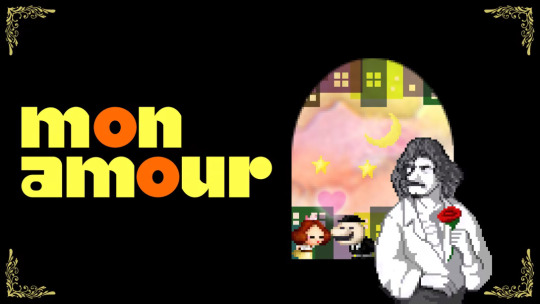
In every medium - movies, books, even games - there are those mad geniuses whose names elicit an immediate reaction. Their works aren't always good, but they are always damn interesting. You've probably heard some of these names - Suda51, Swery65, Hideo Kojima.
Yoshiro Kimura doesn't quite have the same level of fame. Many of his games, with studio Onion Games, have only made it westward in the past few years. None of his games - Moon, Black Bird, Dandy Dungeon - are world-shatteringly great. However, they are always incredibly interesting.
His newest game, Mon Amour, has just launched on Nintendo Switch and Steam. What is it? It's kind of like Flappy Bird, but with a lot more kissing. It's a game that I hated at first, but then couldn't stop. It's weird as hell, but has a lot of heart. In other words, it's certainly a Yoshiro Kimura game.
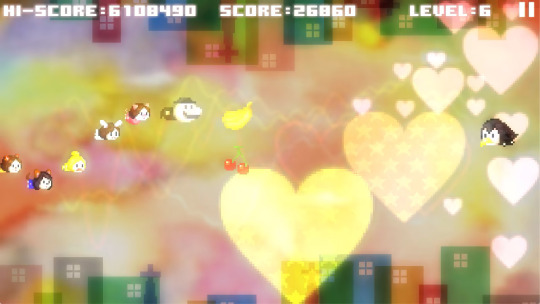
Mon Amour is a fairly minimal game. The mechanics are immediately intuitive, and there are no hour-long cutscenes. There is still a basic story presented as a framing device for what you see on the screen, and it is worth passing along as it does set the mood for what you are about to experience. Three love-starved witches have kidnapped your princess and taken her off to the land of Babastille. Along with her, they have kidnapped all 64 members of her court. It's up to you to rescue them... with the power of your lips. That's right. Rather than stomping on a hyperactive turtle, you rescue each lovely lady by kissing them.
Mon Amour is a collection of single-screen stages, where you attempt to fly from the left and plant your lips on the lady waiting to the right. You move to the right by pumping a button to stay airborne, but you must avoid the buildings both above and below you. Hitting either is instant death, unless you have protection.
The current target of your affections is constantly rotating her head the entire time, and when you run into her, she spits out a trail of hearts in the direction she was facing. When you enter the next level, those hearts remain in place, and you can increase your score by collecting some of them while flying towards your new target. The hearts merge together when they touch into a larger heart. The larger the heart - the more points you receive.
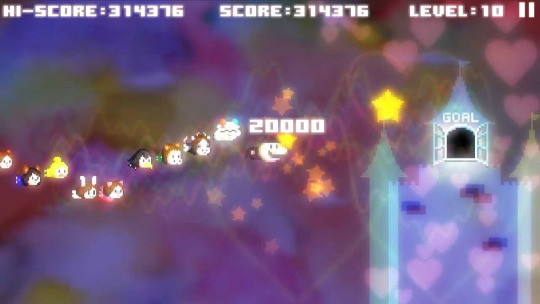
There are also explosive fruits that you can run into to remove some of the obstacles from your path, and fruits that give you a single-use shield. In the case of both fruit and hearts, you can either pick them up immediately, or leave them for a little later on. The game is sectioned into stages, and fruit and hearts persist over the different screens in a stage. It is often worth leaving the fruit for a bit to take care of the harder traps that come later in the stage. Likewise, leaving hearts on the screen and trying to shoot more hearts in their direction is worthwhile to get a bigger score bonus.
The women you collect form a sort of health bar. If you take a hit, you lose one of the women. To truly complete the game, you need to collect 64, so you don't want to lose any of them. However, you still get a score based on how many you have collected before dying or getting to the end of the 50th level.
From this point, there aren't any major surprises. The levels grow harder - with narrower windows to float through and obstacles to avoid - and the scenery changes, but this is mainly a single-button game about floating into the faces of kidnapped women. It's weird, but certainly not the weirdest premise in gaming.
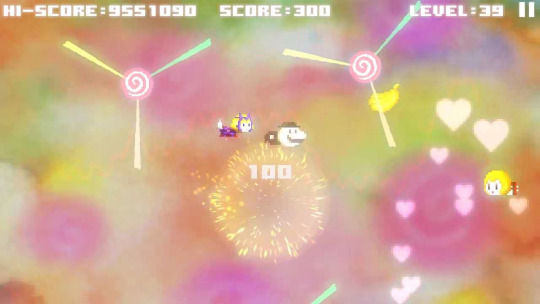
This all sounds simple, and it mostly is, but it takes a lot of work to master. The page for the game on the Switch eShop warns that "there is a 99% change you'll instantly die as soon as you press start". They aren't wrong. There is absolutely no introduction, and you will immediately sink to the bottom of the screen and die unless you are fast on the draw. It took me several tries to get the timing down to even get to the first target.
To be honest, I actively disliked the game for the first 20 minutes or so that I played it. It felt awful to just spam the button to stay afloat, and I just didn't get it. I don't know what changed, but I started to get a little further and a little further, and then it sort of clicked. I started to have a lot more fun as I internalized the rhythm of the controls.
The mechanics are simple, but being good at this game takes a lot of work. Learning how to direct your momentum, when to pick up hearts and fruits, and how to direct the spurt of new hearts (that's certainly a phrase) all requires practice. Mon Amour certainly has that addictive quality where you find yourself clicking start for one more round, even when you meant to move on to some other activity.

Mon Amour looks really cool. The pixel art is incredibly charming, and the little characters have a surprising amount of personality. The stages are colorful and varied, and there is this weird dream-like vibe to the whole experience - with blur, swirls, and a psychedelic color palate. The soundtrack also certainly contributes to that vibe. The game blends scat-singing and improvisational jazz as you float across screen after screen. None of these components make all that much sense in isolation, but they do gel in this weirdly-compelling way.
In the end, I'm not completely sure how I feel about Mon Amour. Do I love it? I can't give an unqualified "yes." It's frustrating and not always fun. I mentioned above that I hated it until it clicked. Even after that point, I've gone back and forth a little with my opinion on the game. Still, it can be addictive, and there are sessions where I have had a lot of fun. I also love the silliness of the premise, look, and soundtrack. The game is charming as hell.
In other words, it is a Yoshiro Kimura game. Flawed, but also something wholly unique, charming, and just interestingly weird. Mon Amour lacks the brilliance of Moon (seriously, check it out). Still, in the end, I recommend checking it out if the gameplay sound fun, or if you're looking for a unique way to waste a little time.
A copy of the game was provided for this review.
Official Website
Nintendo eShop
0 notes